
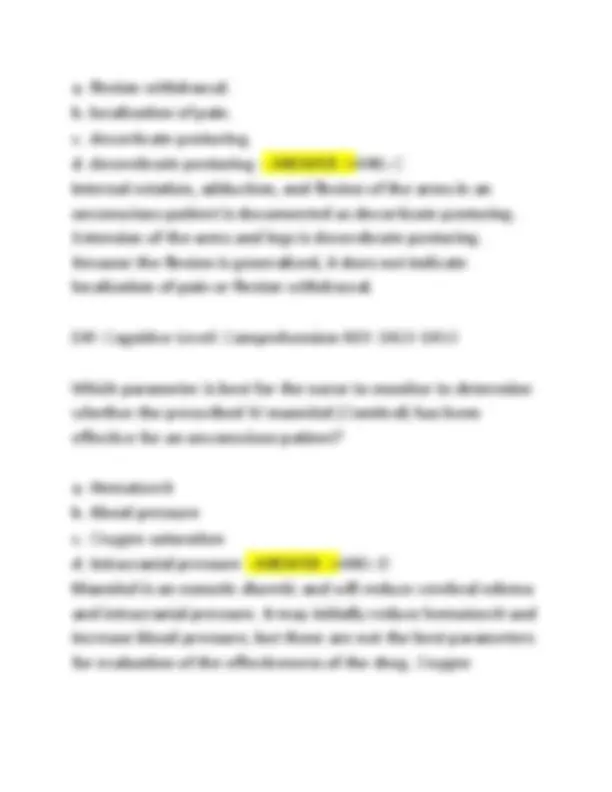
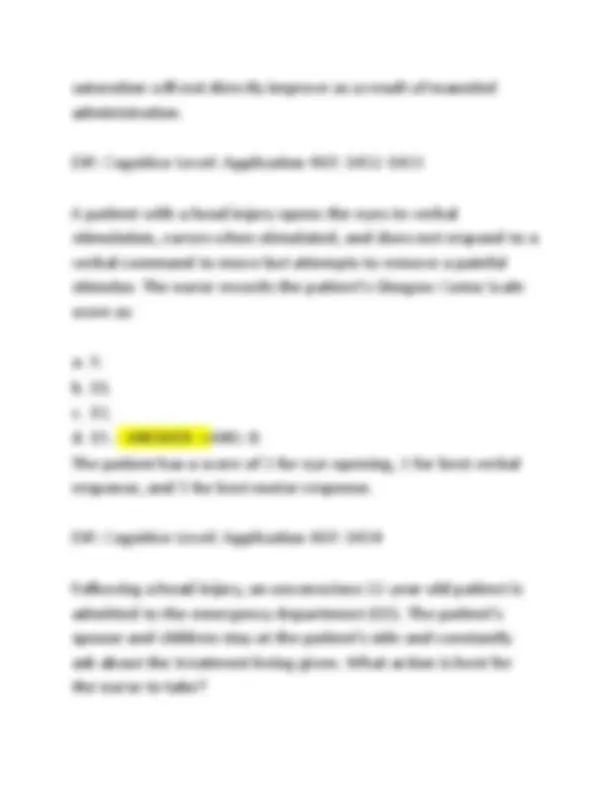
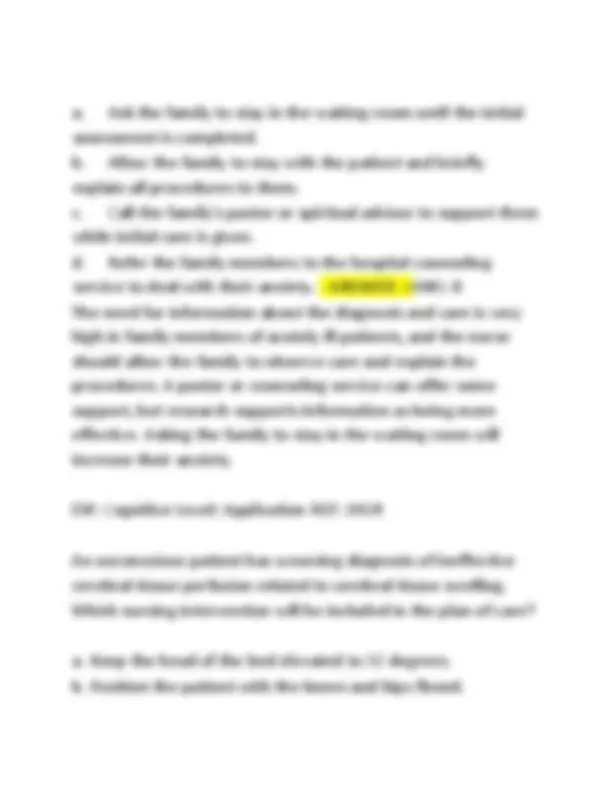
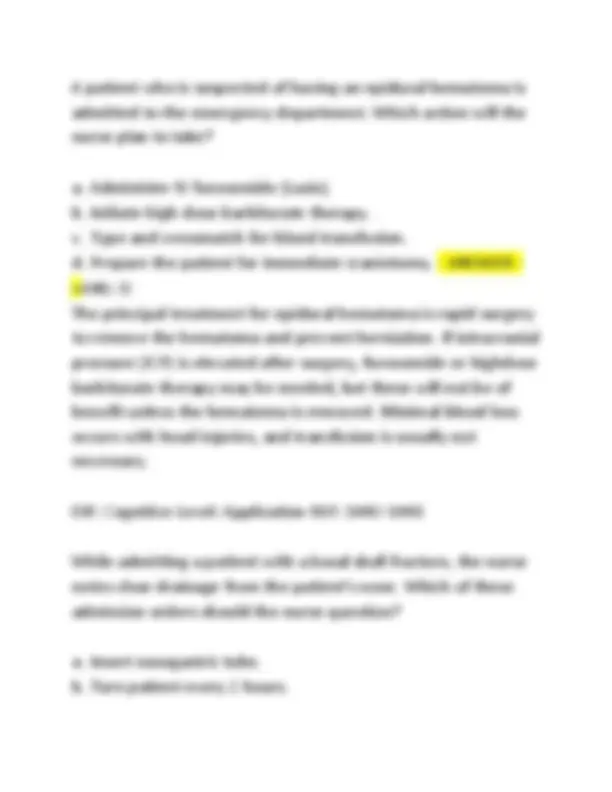
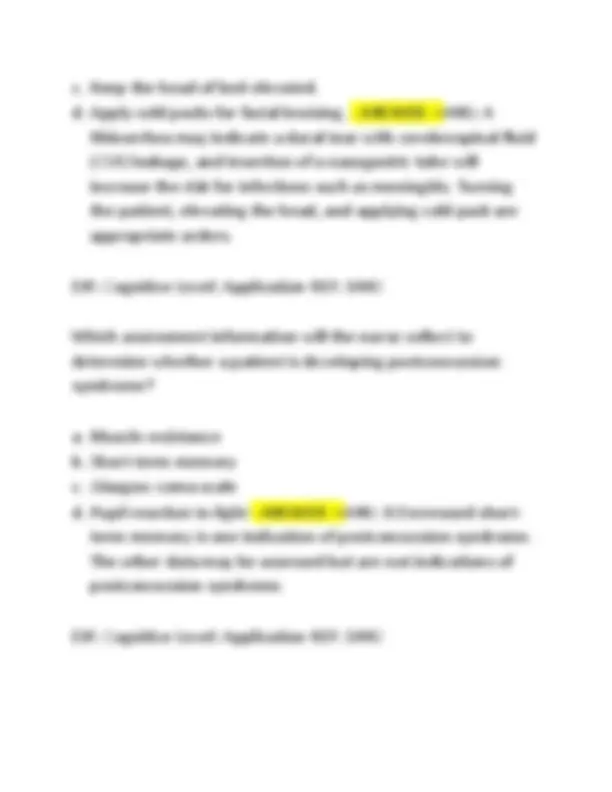
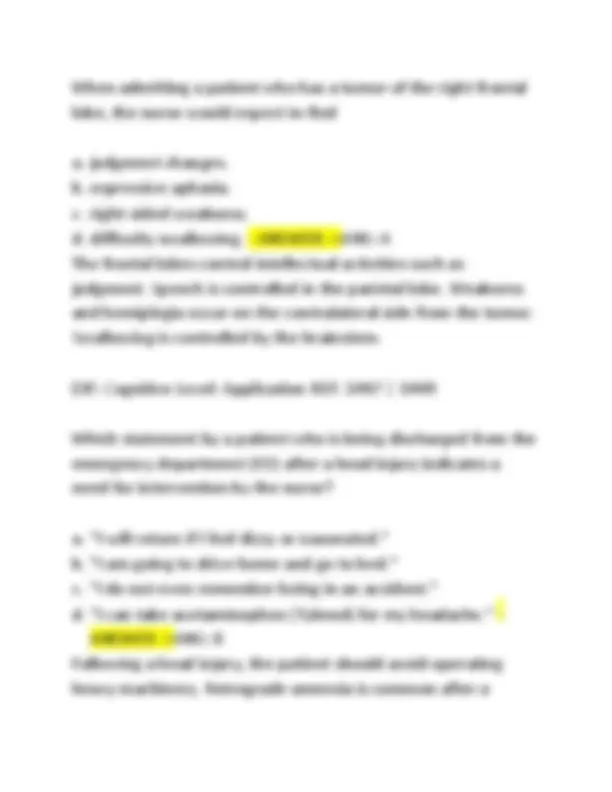
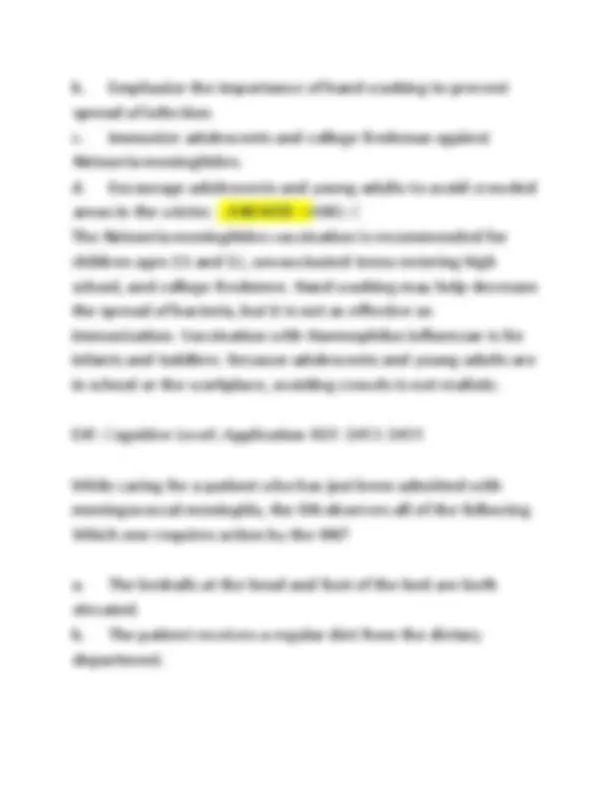
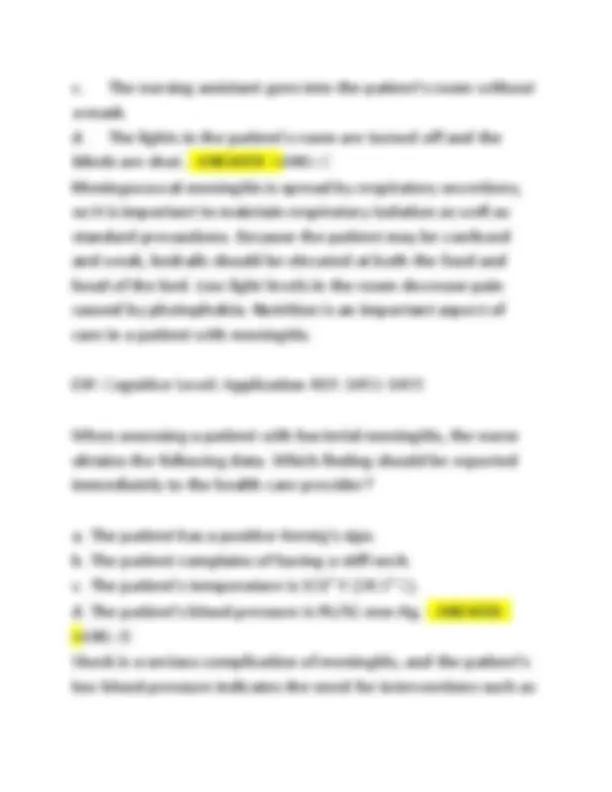
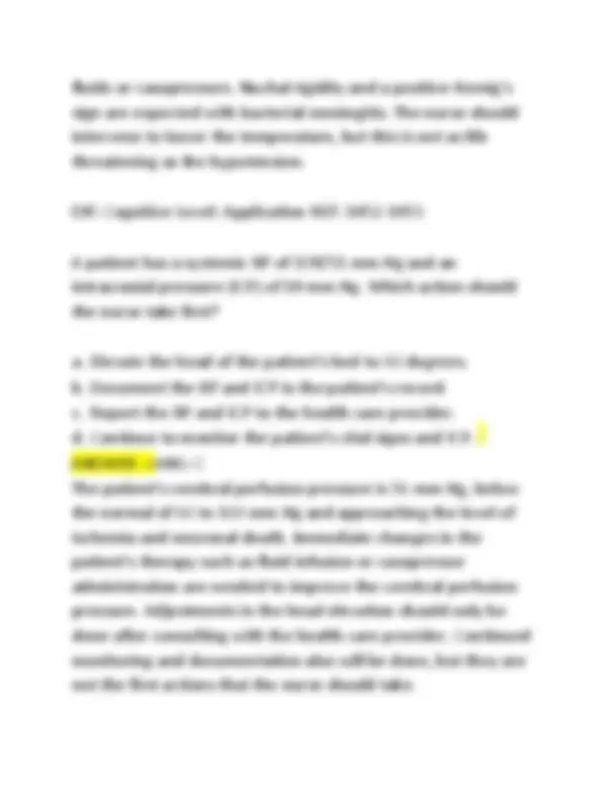
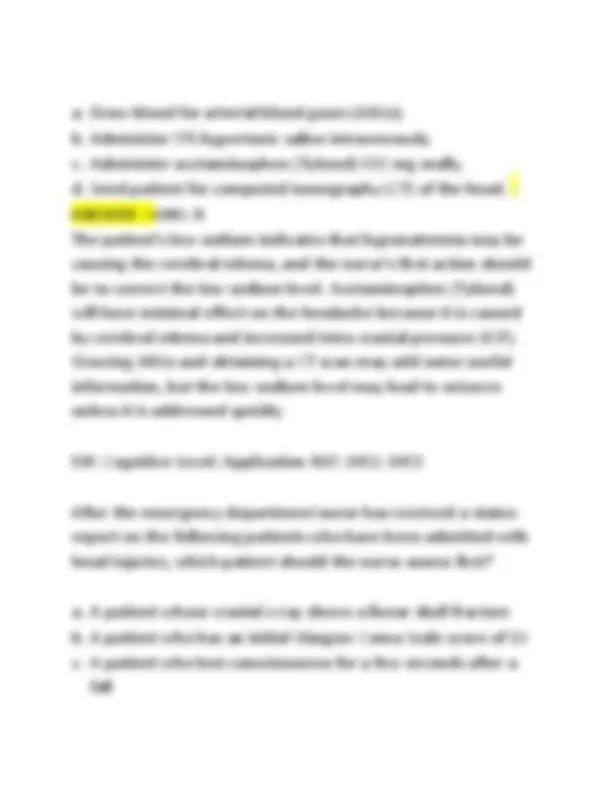
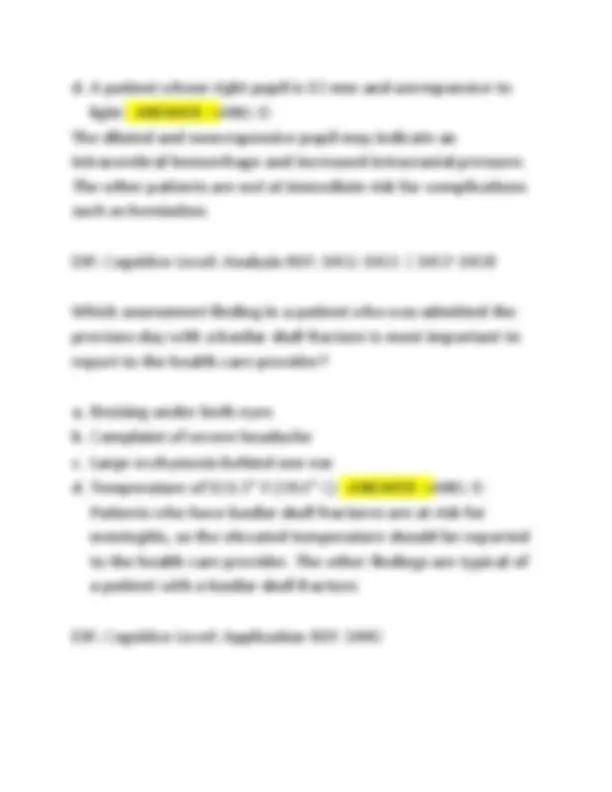

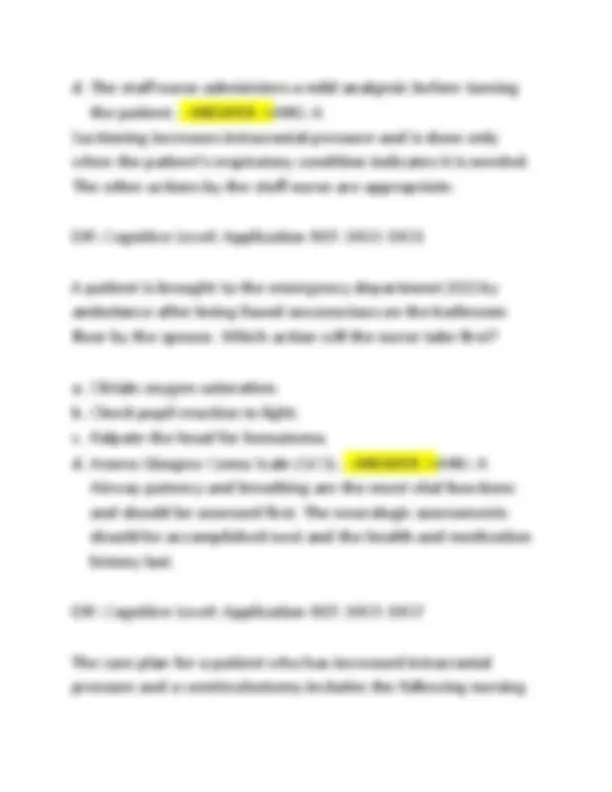
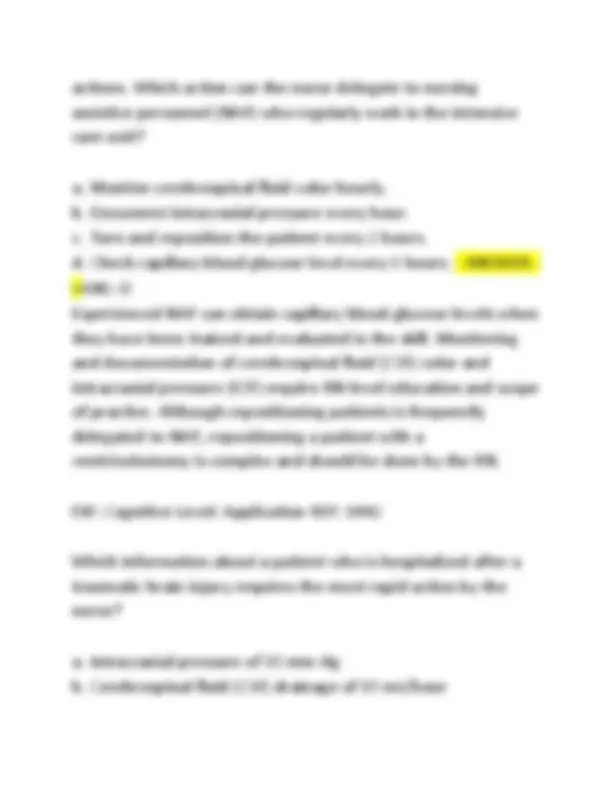
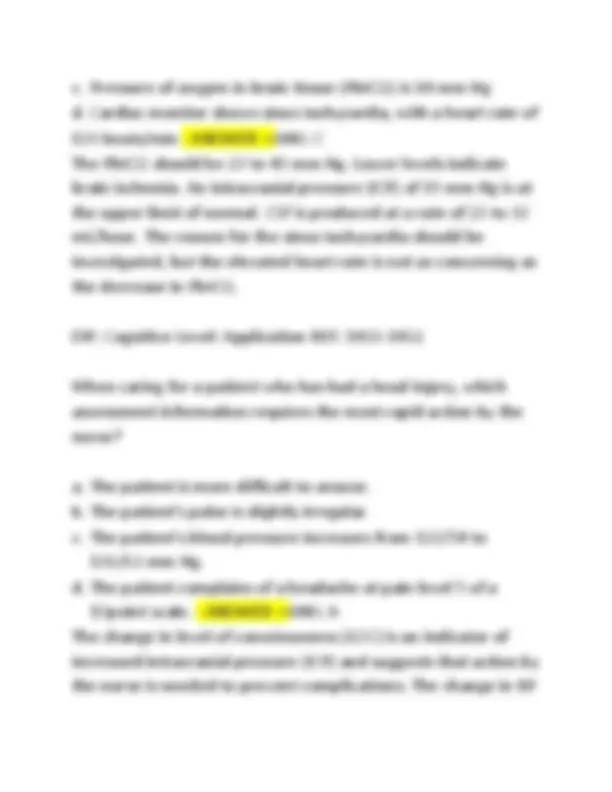
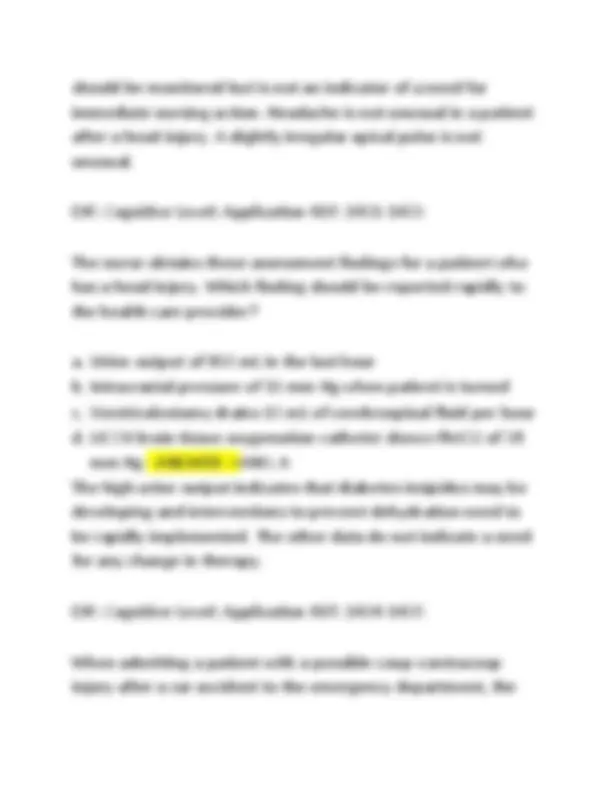
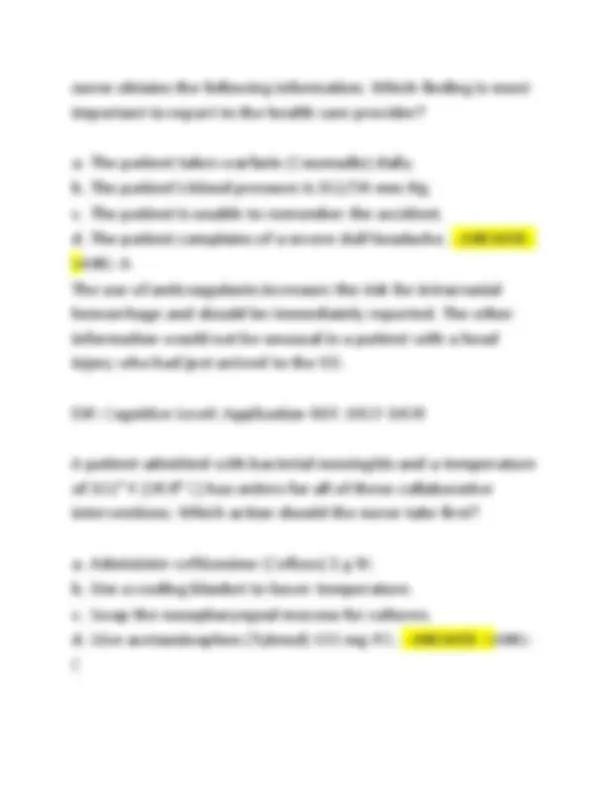
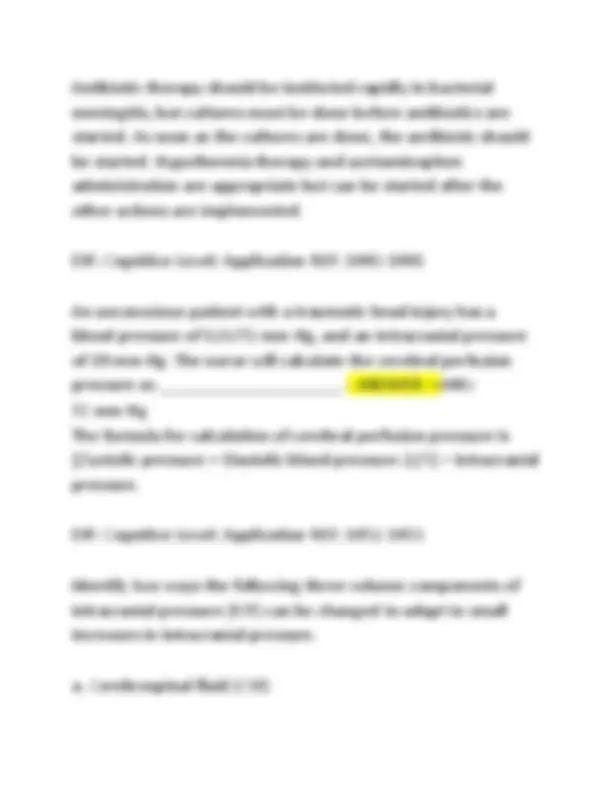
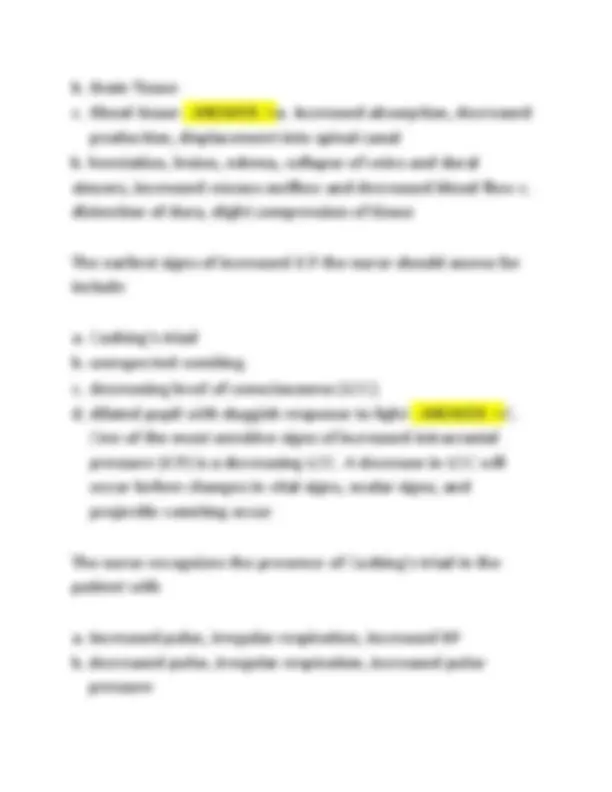
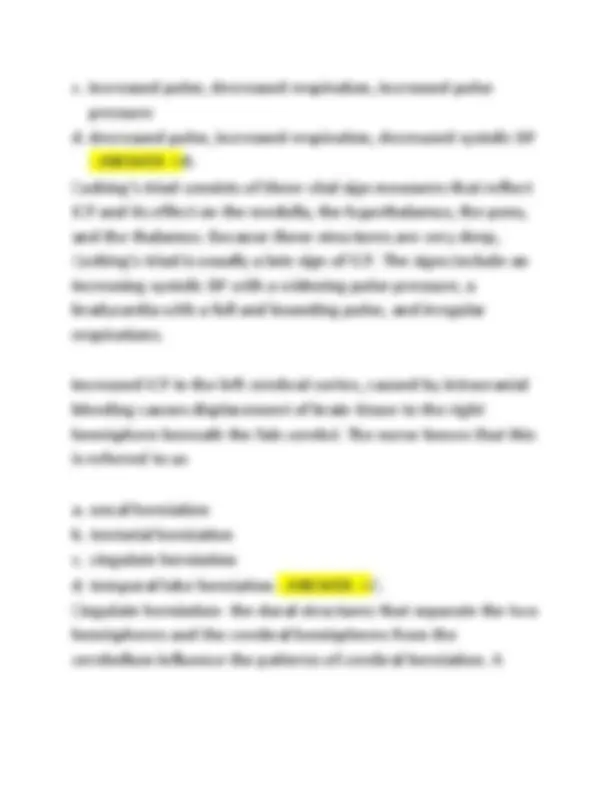
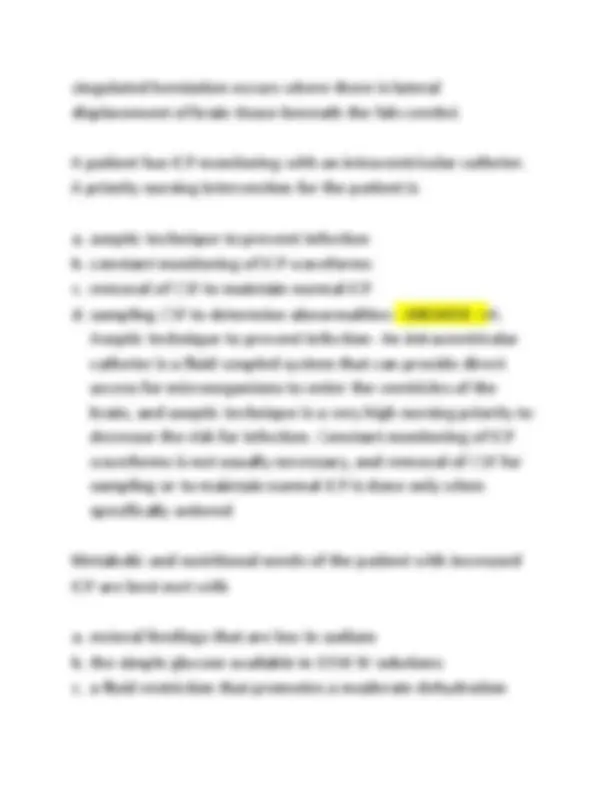
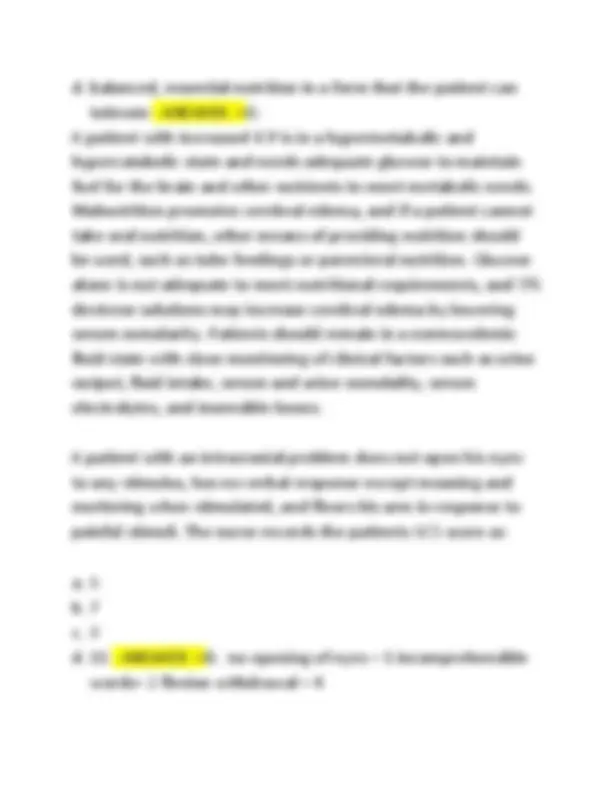
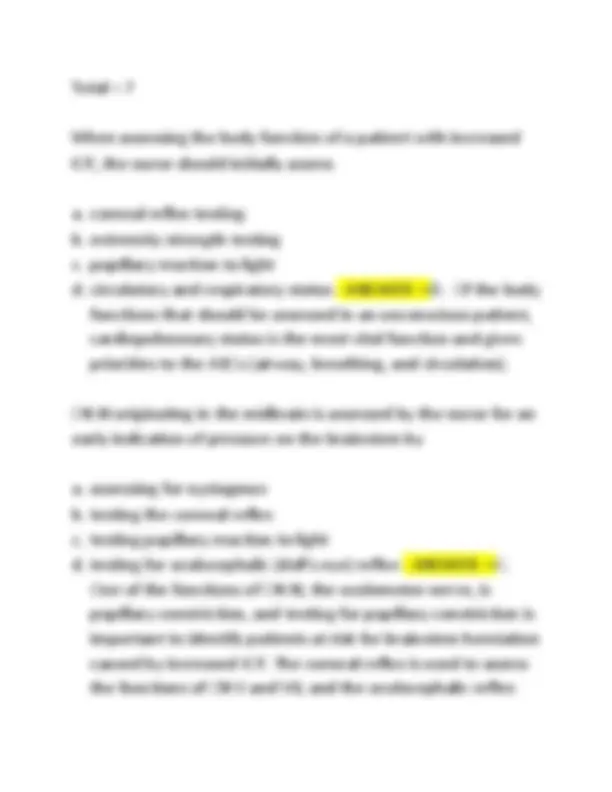
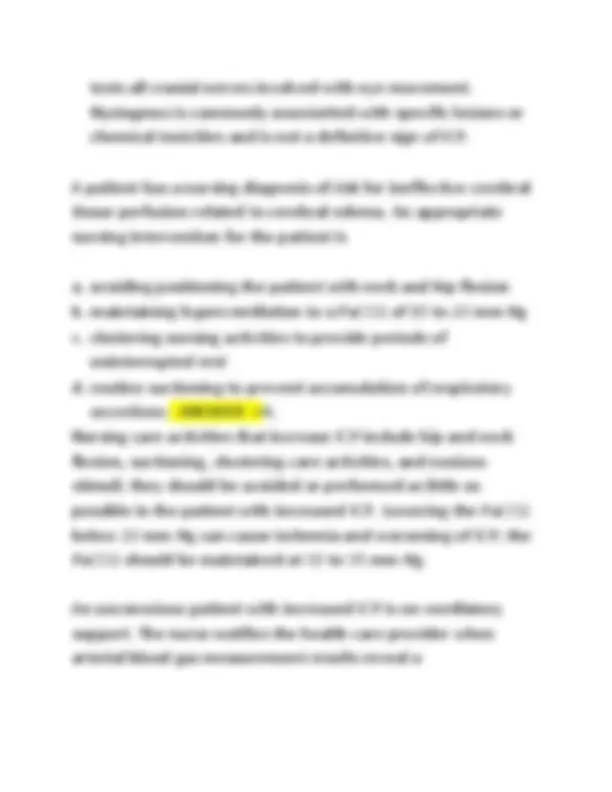
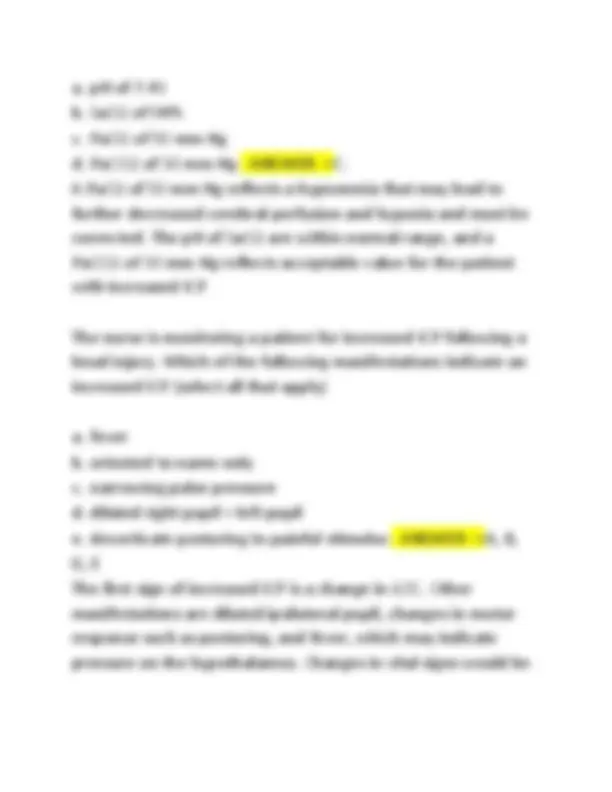
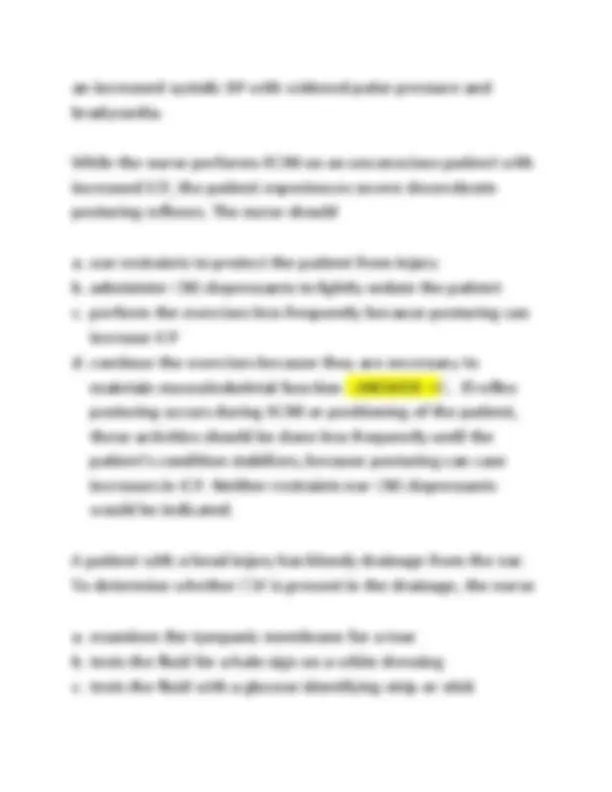
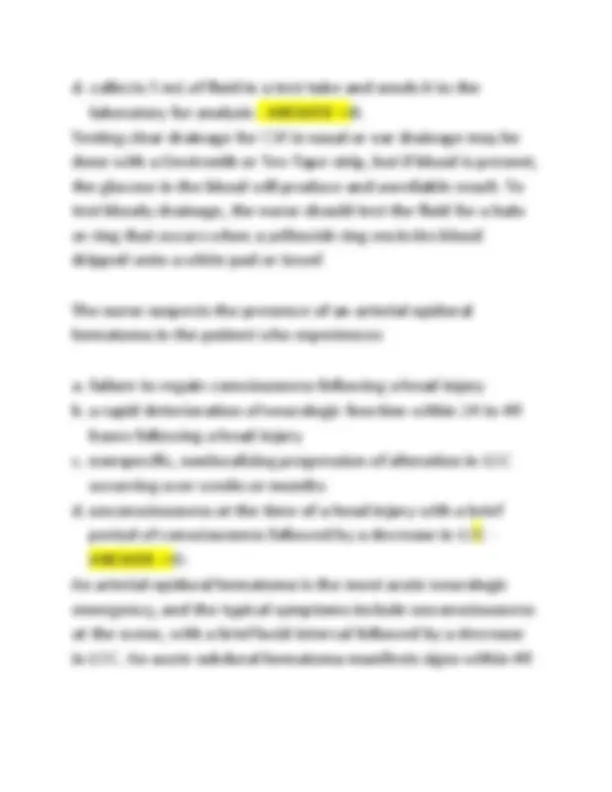
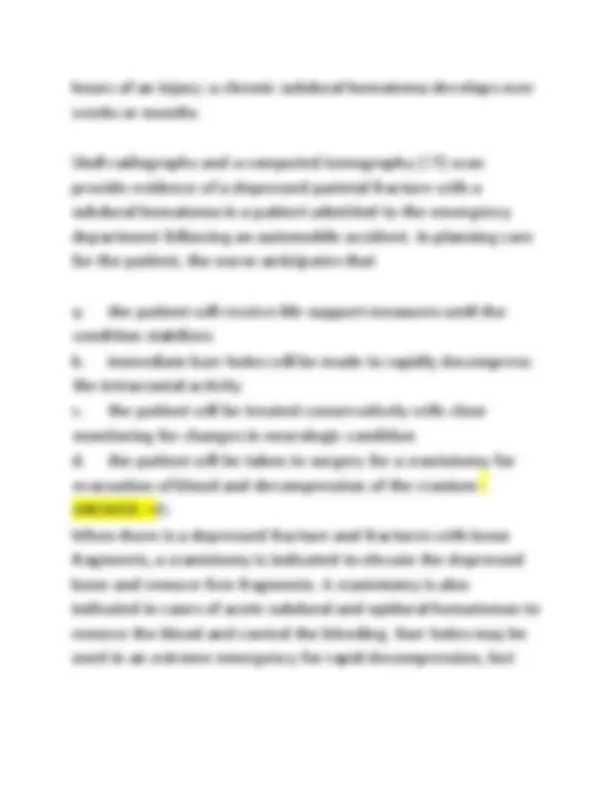
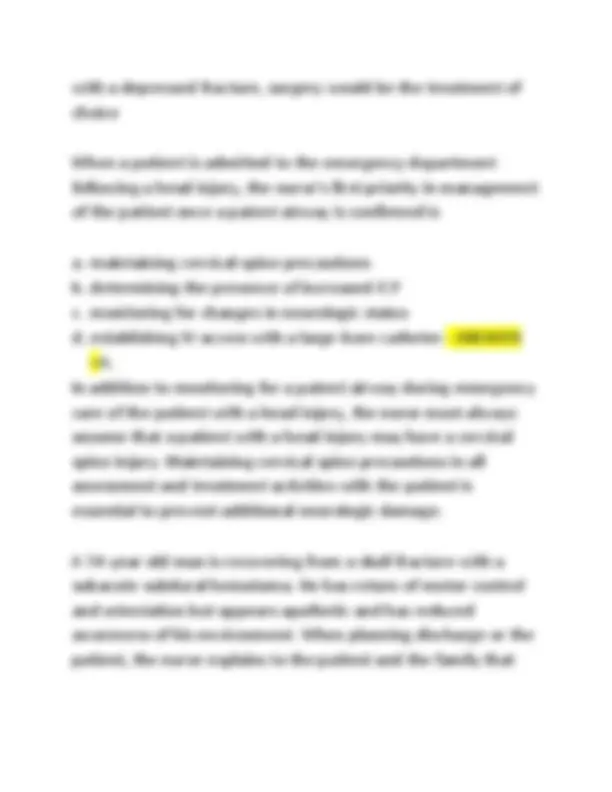
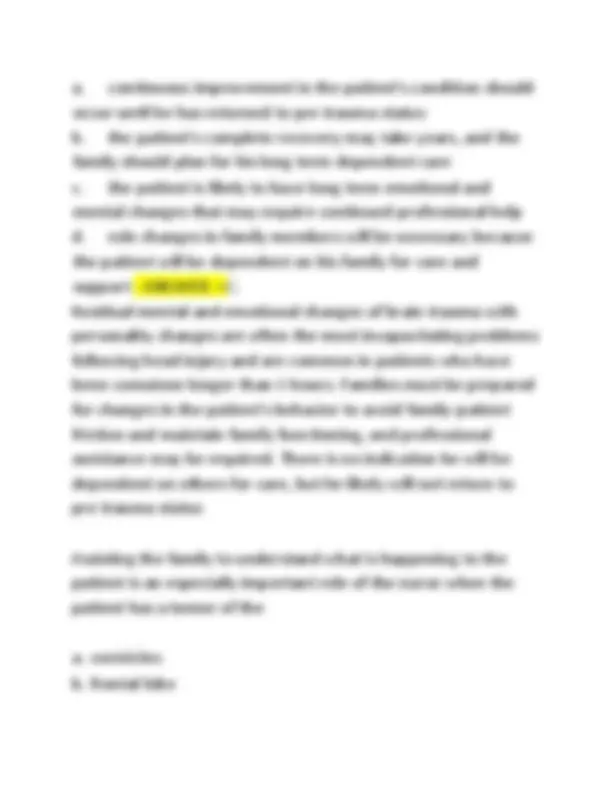
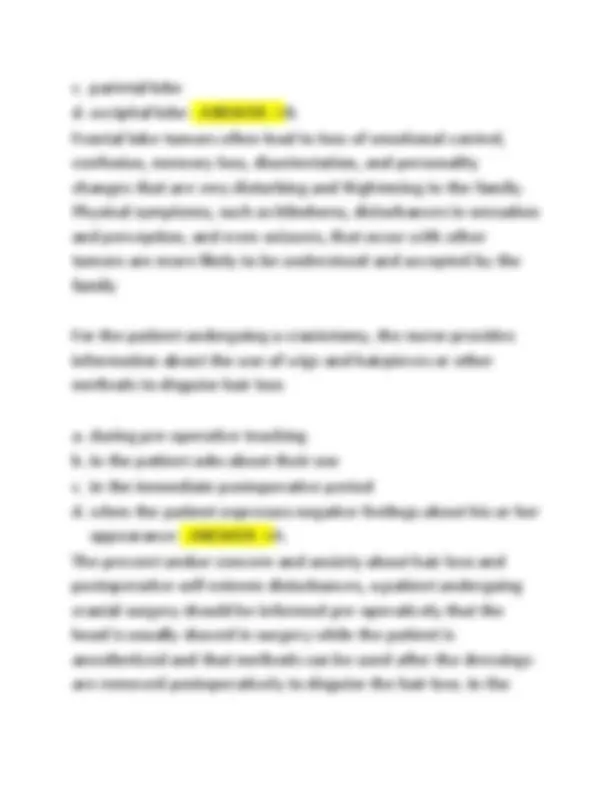
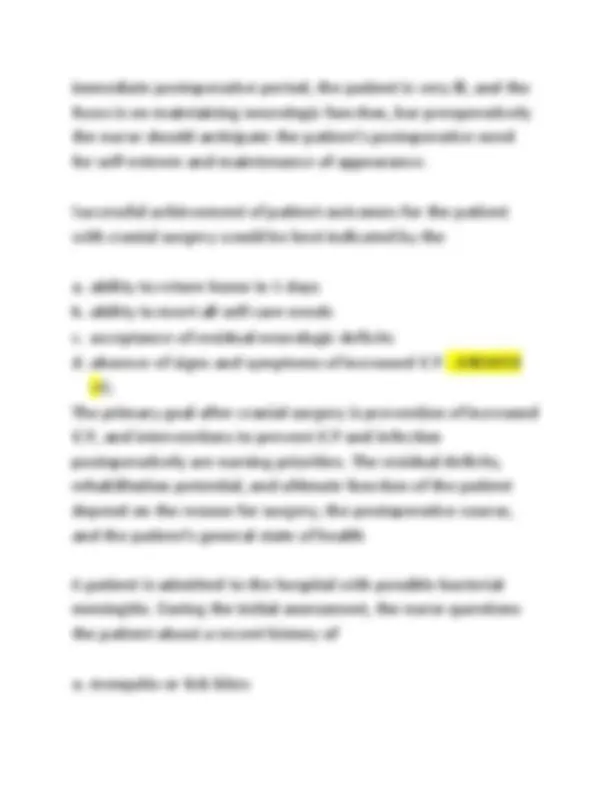
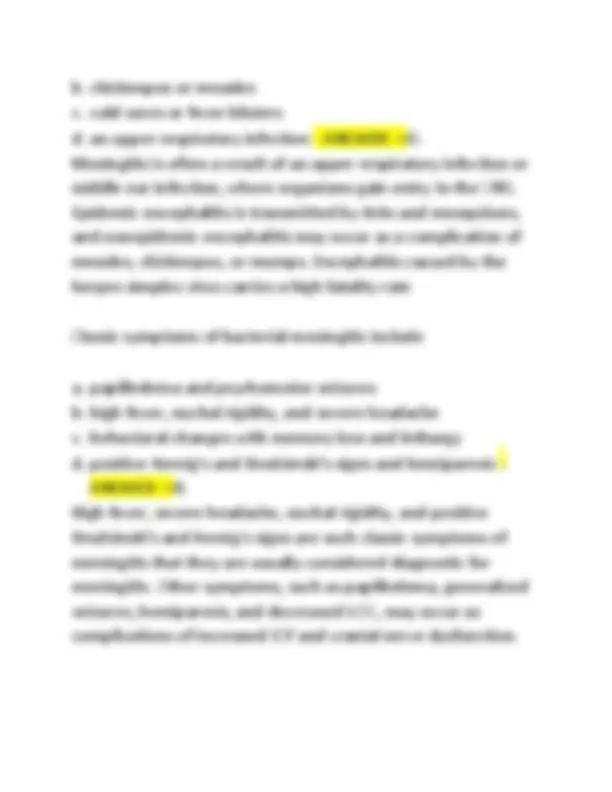
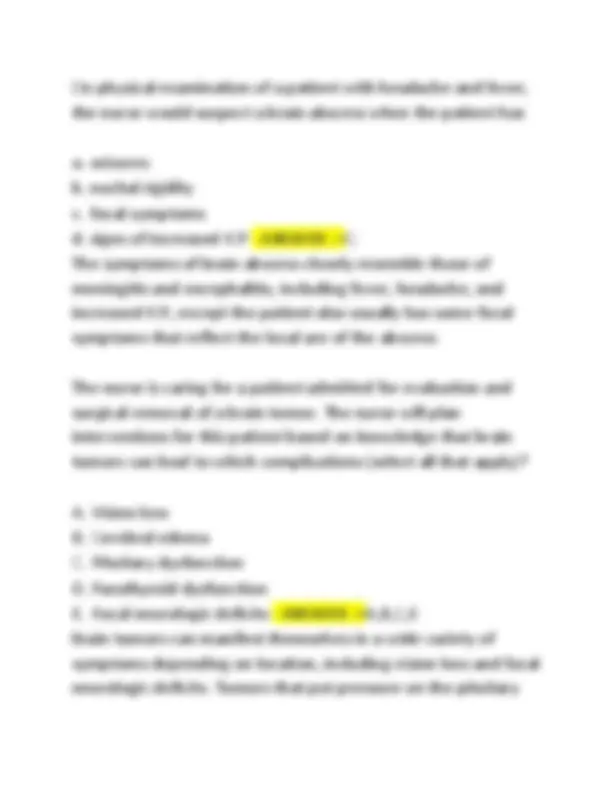
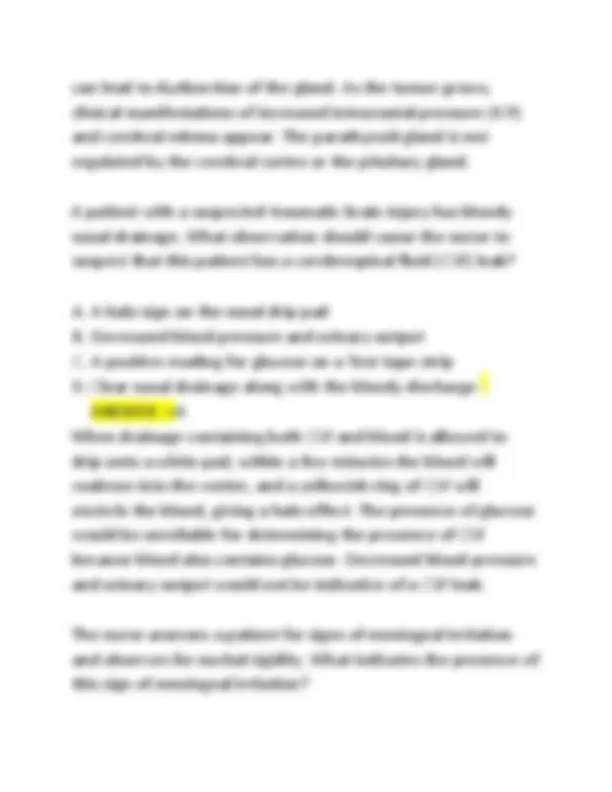
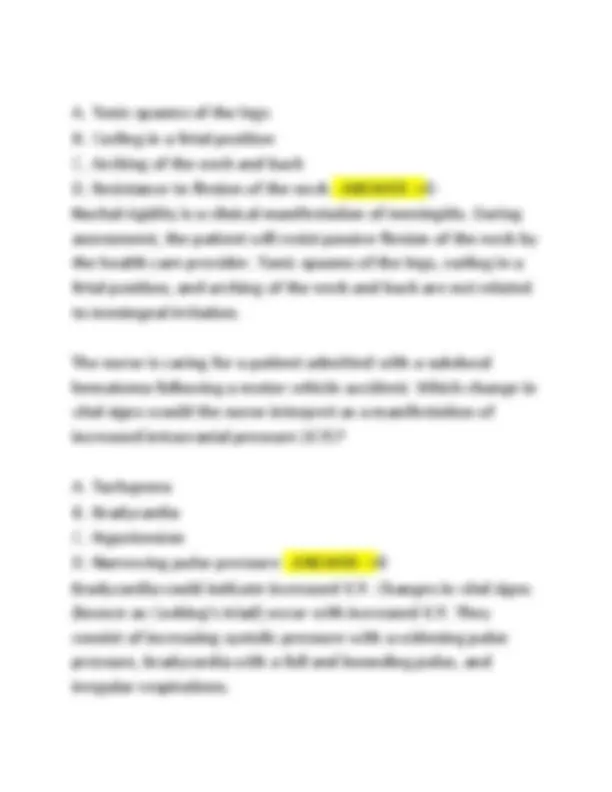
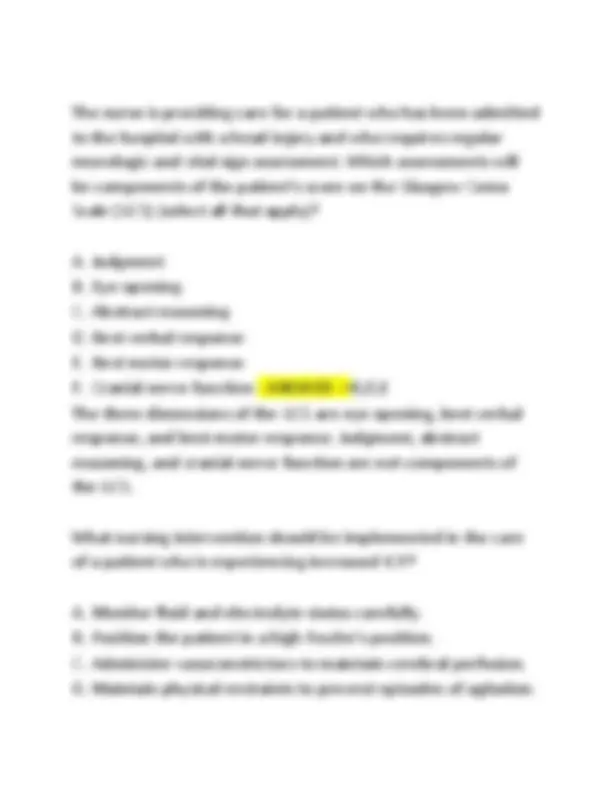
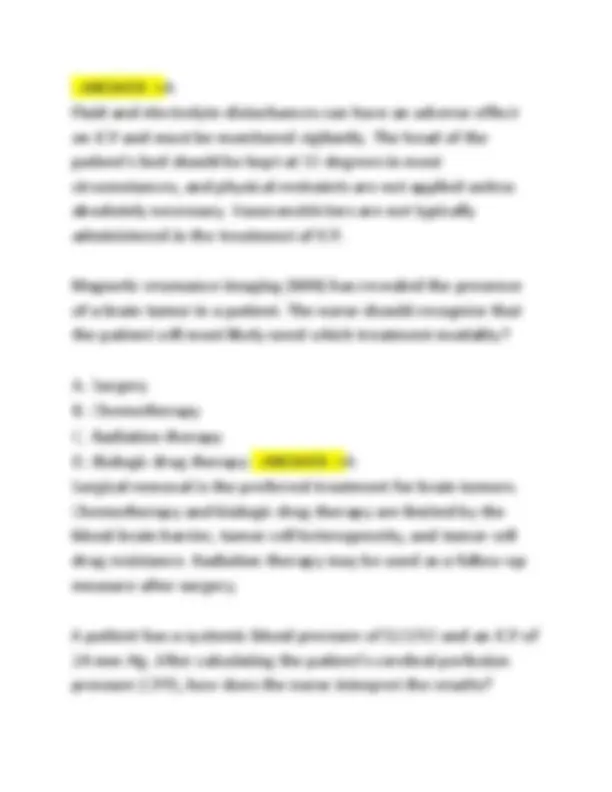
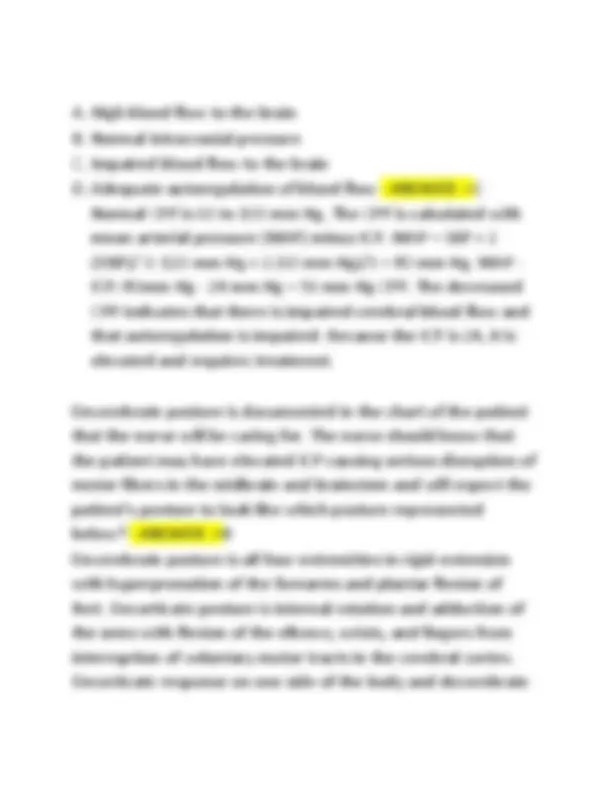
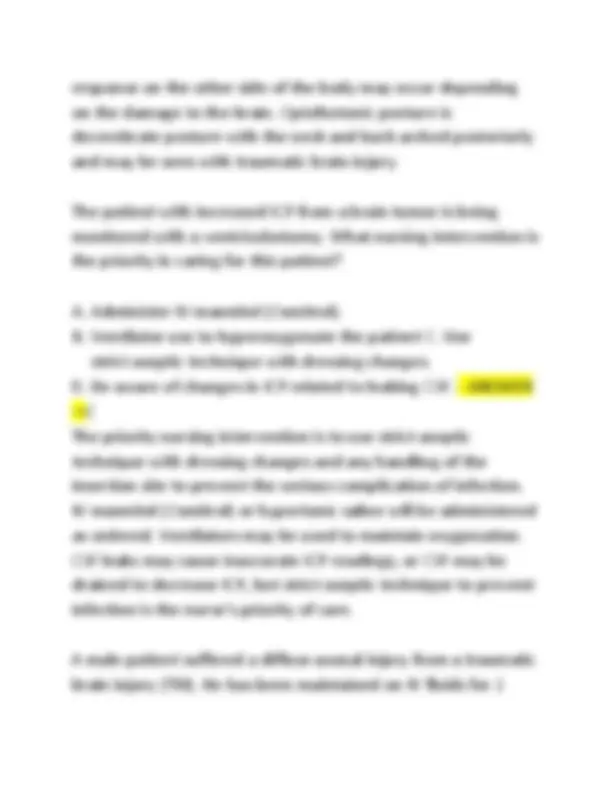
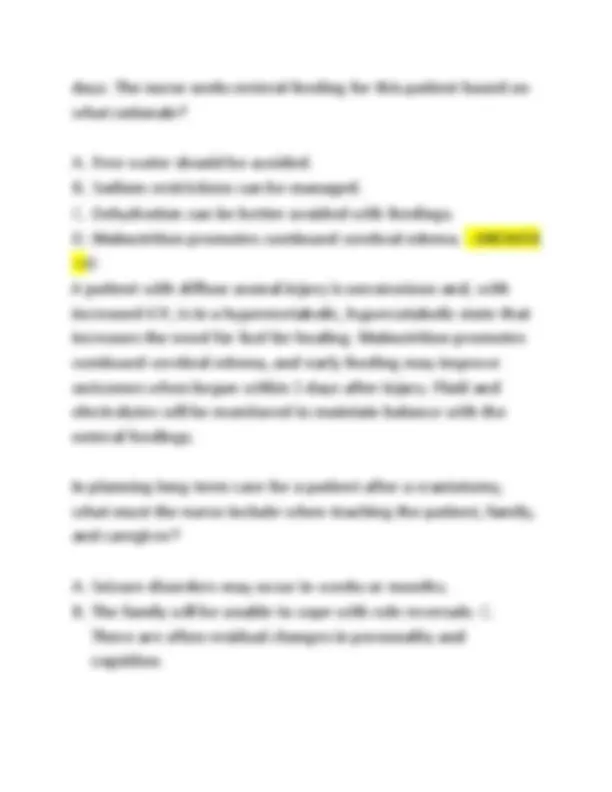
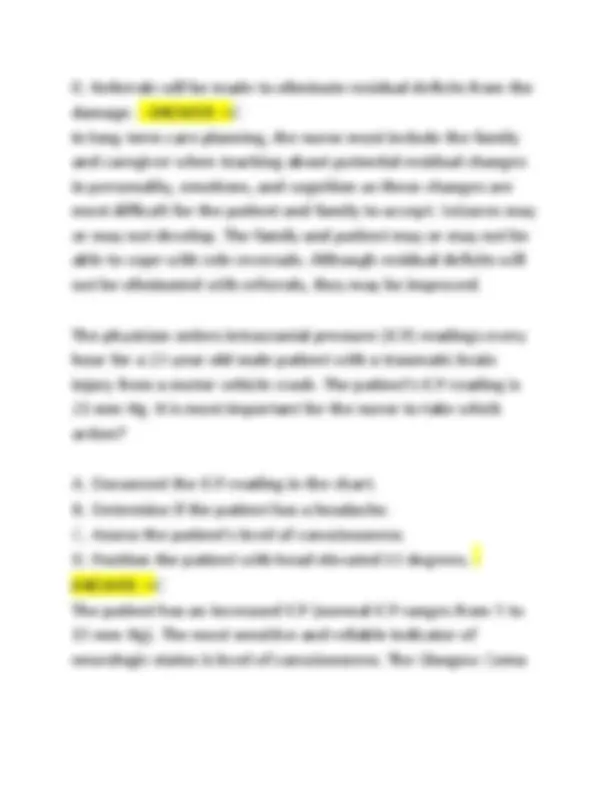
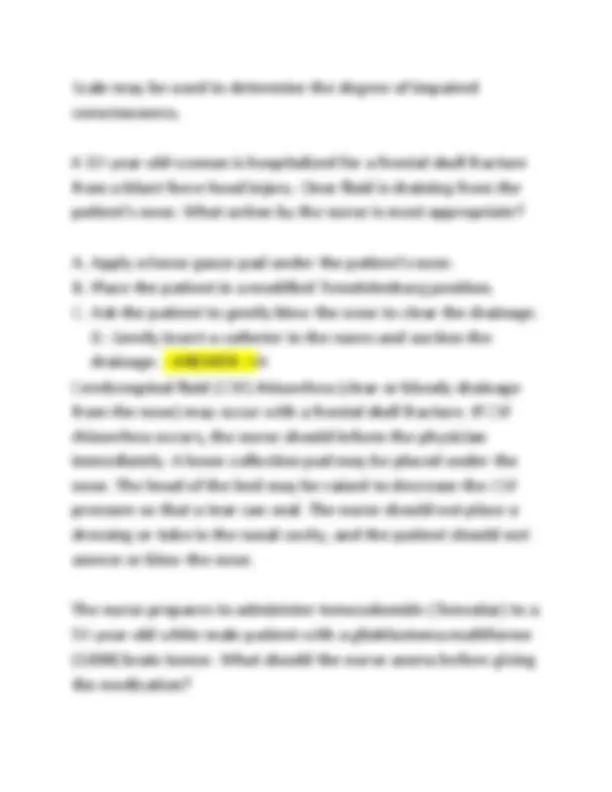
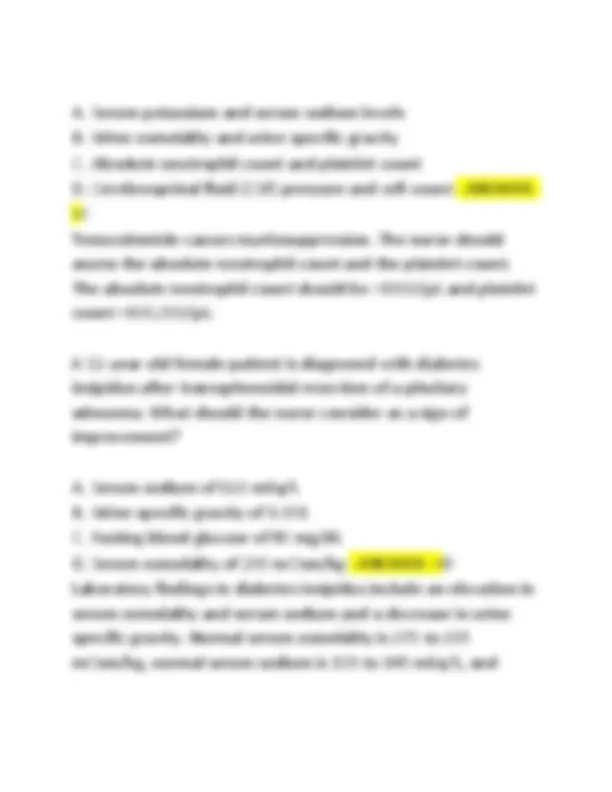
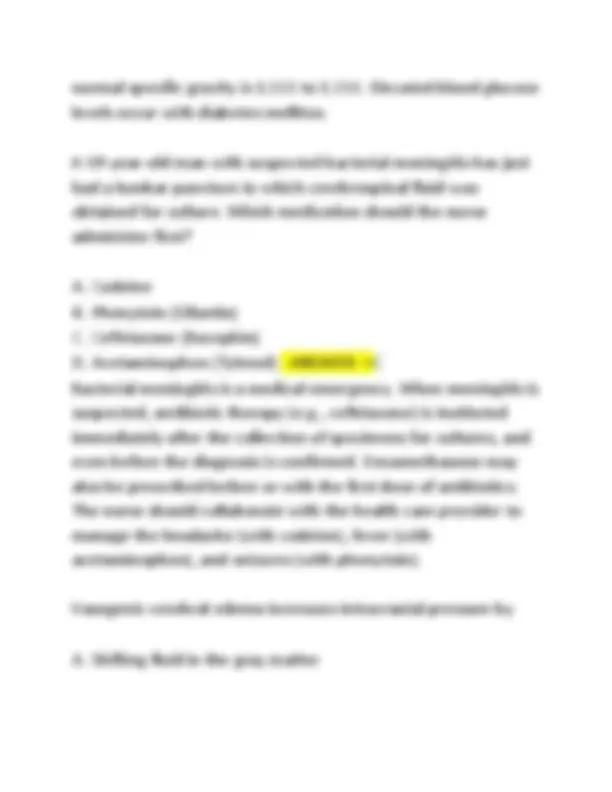
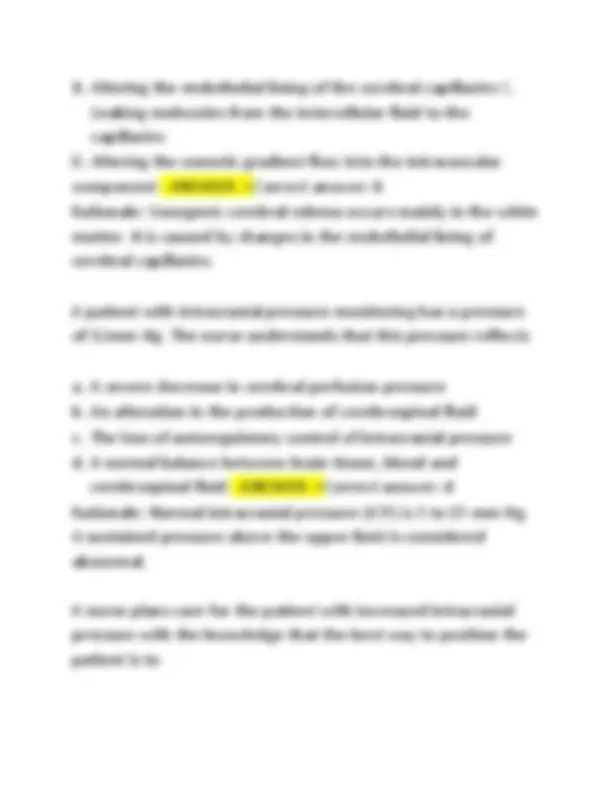
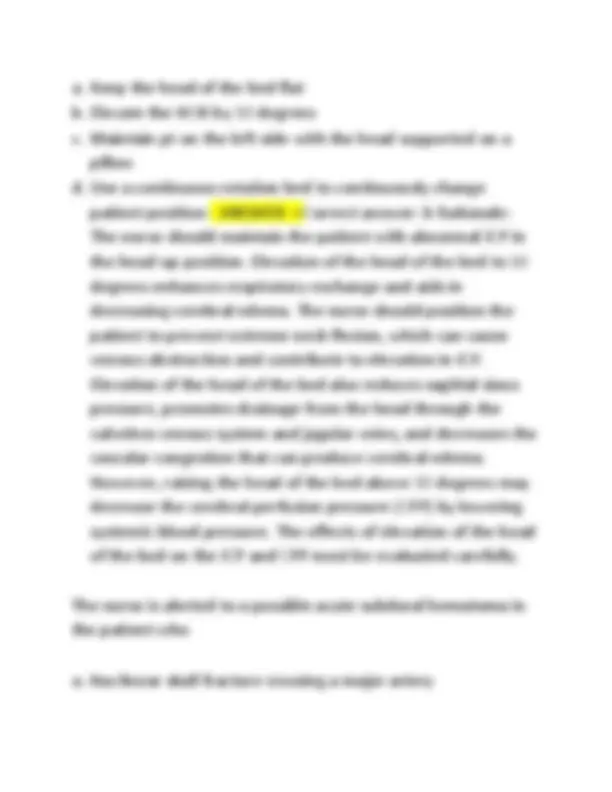
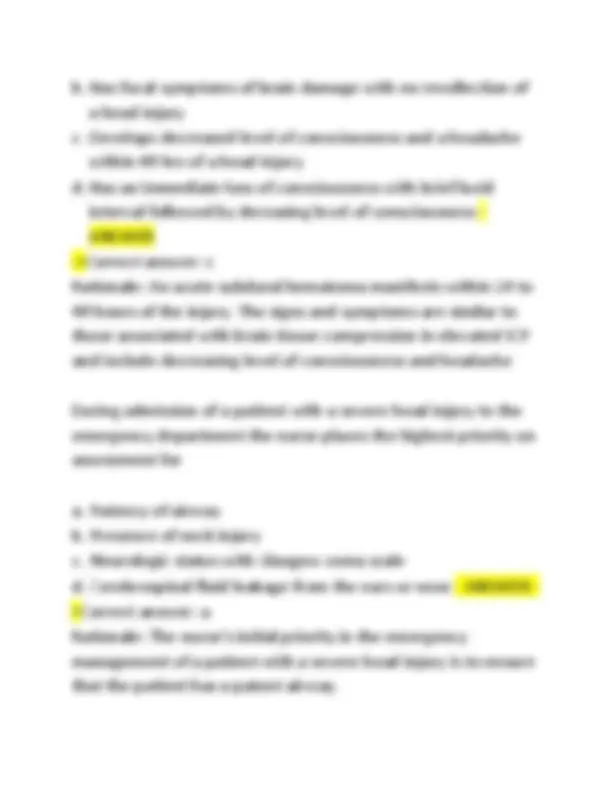
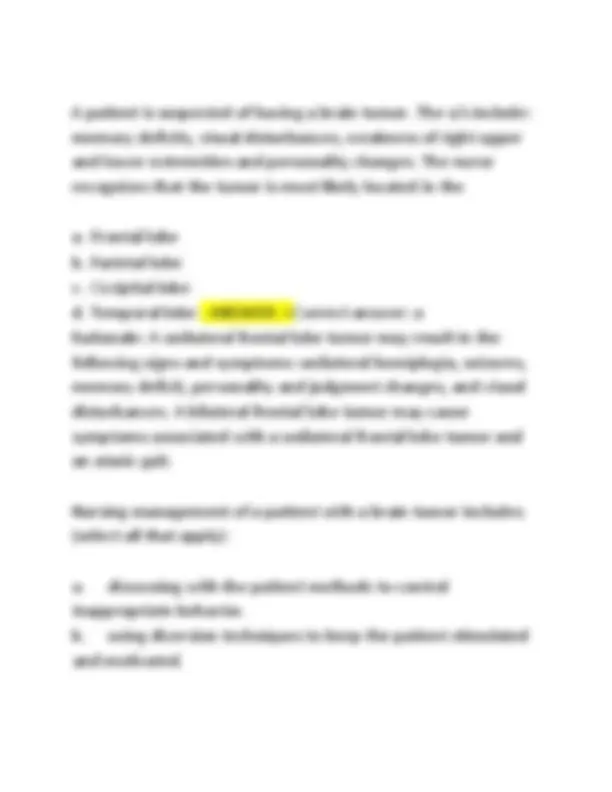
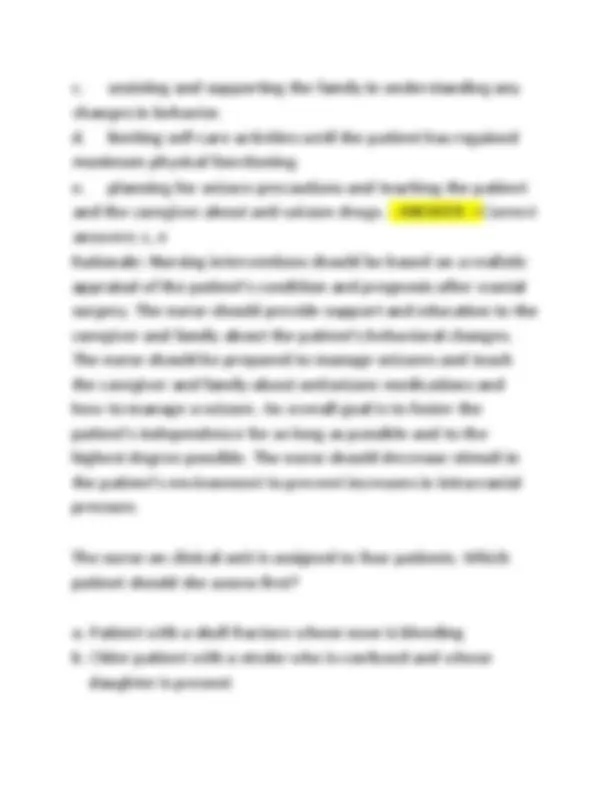
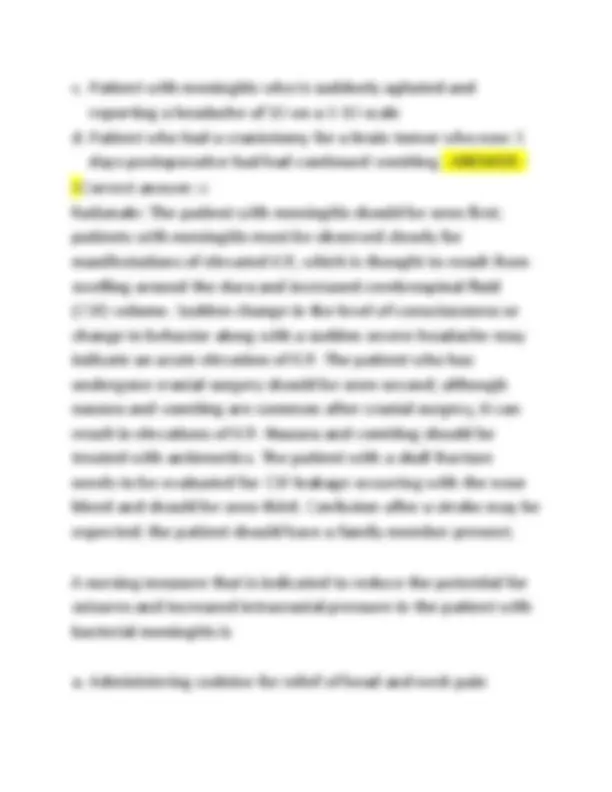
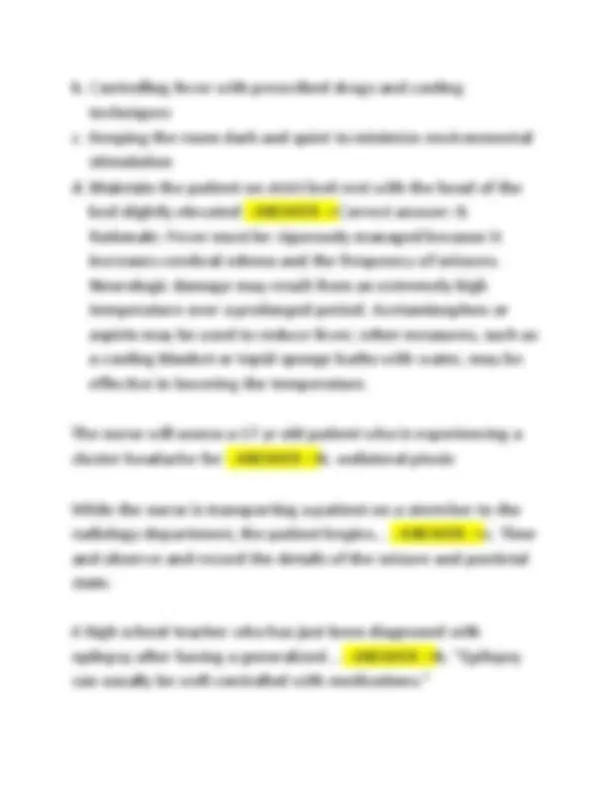
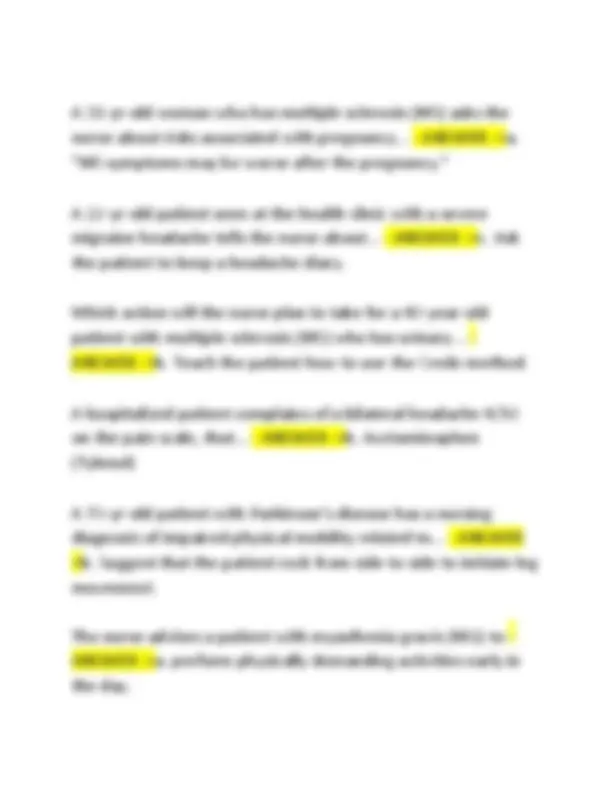
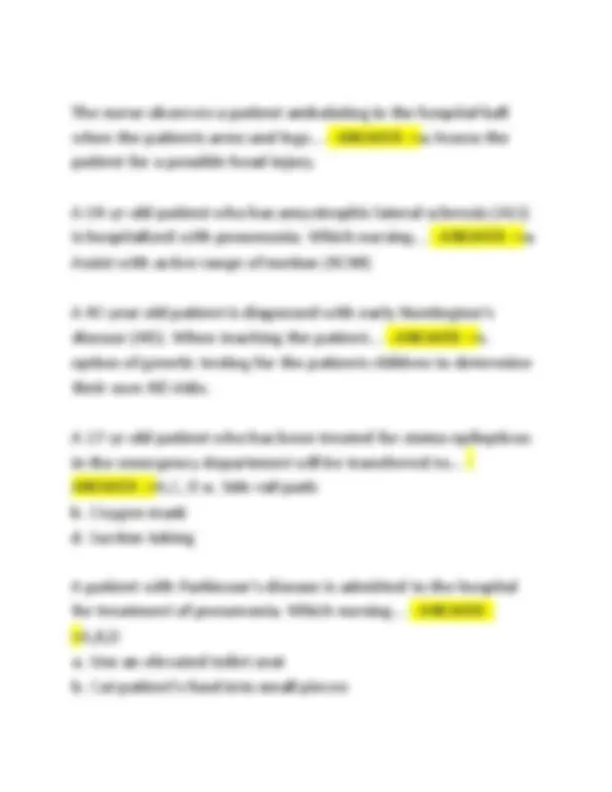
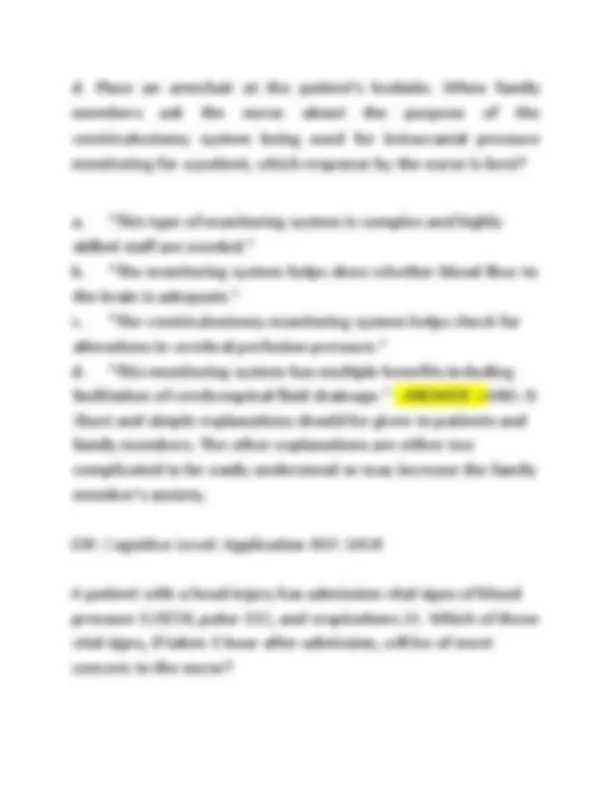
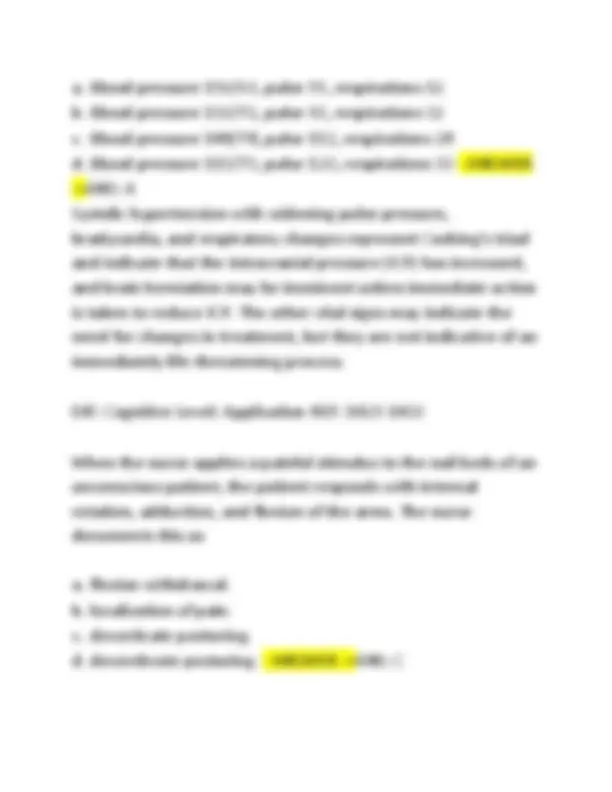
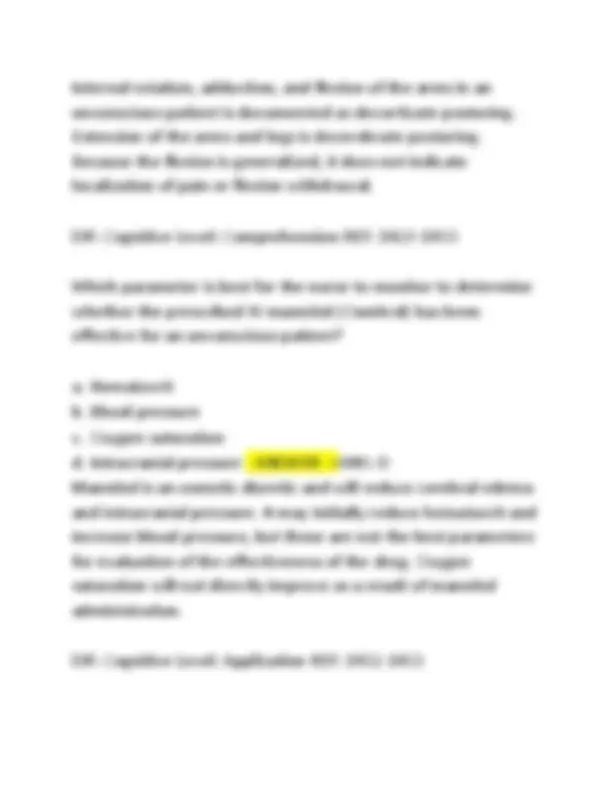
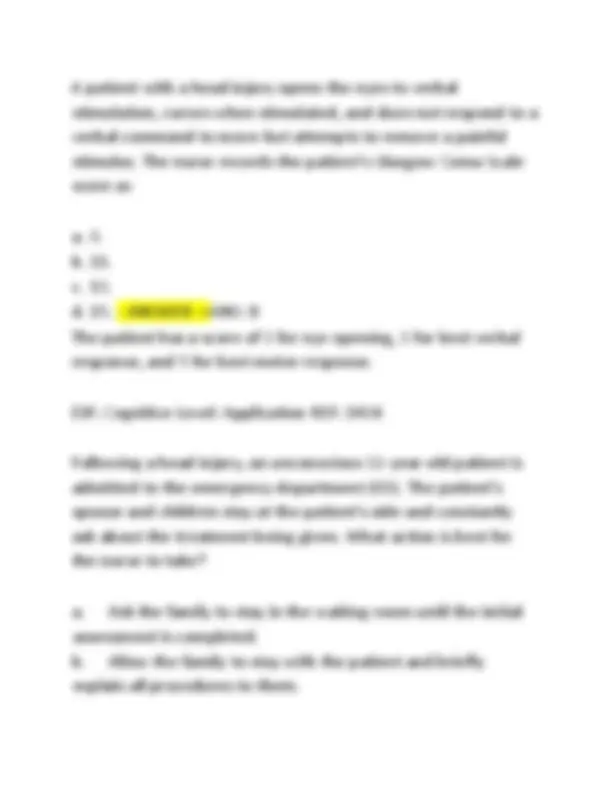
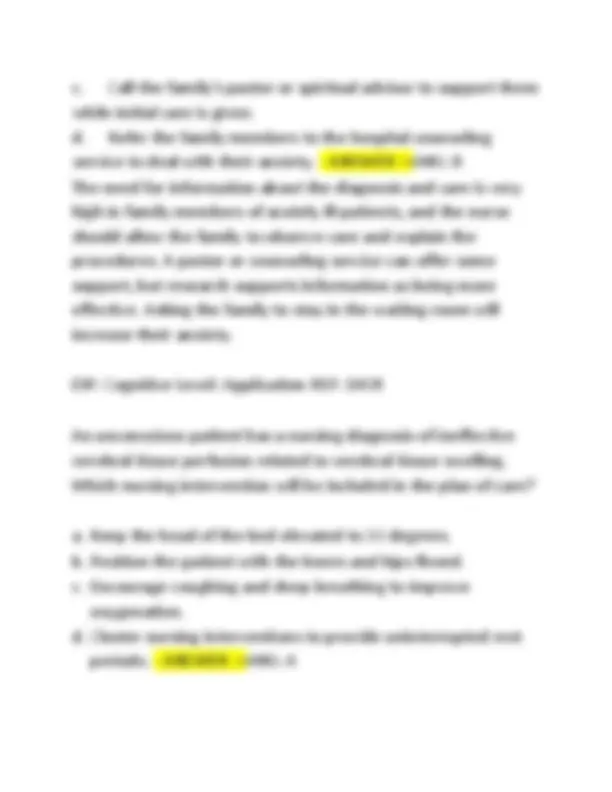
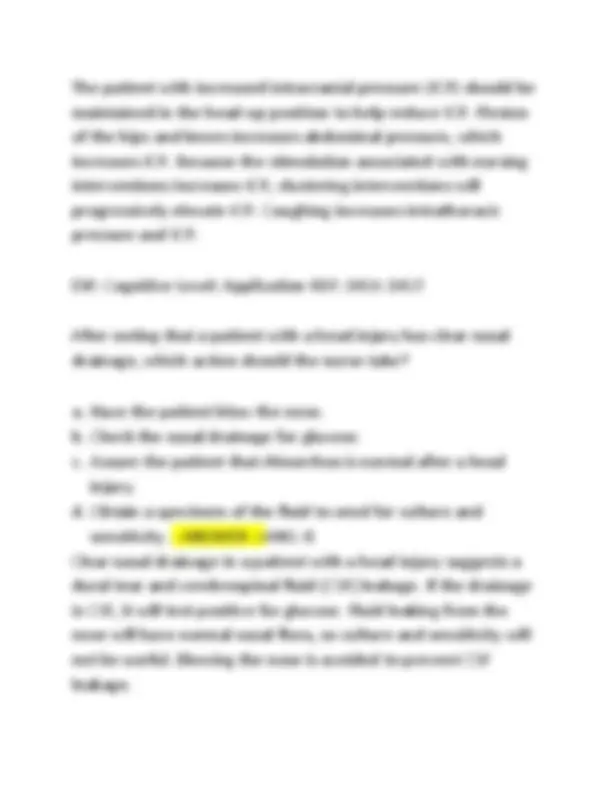
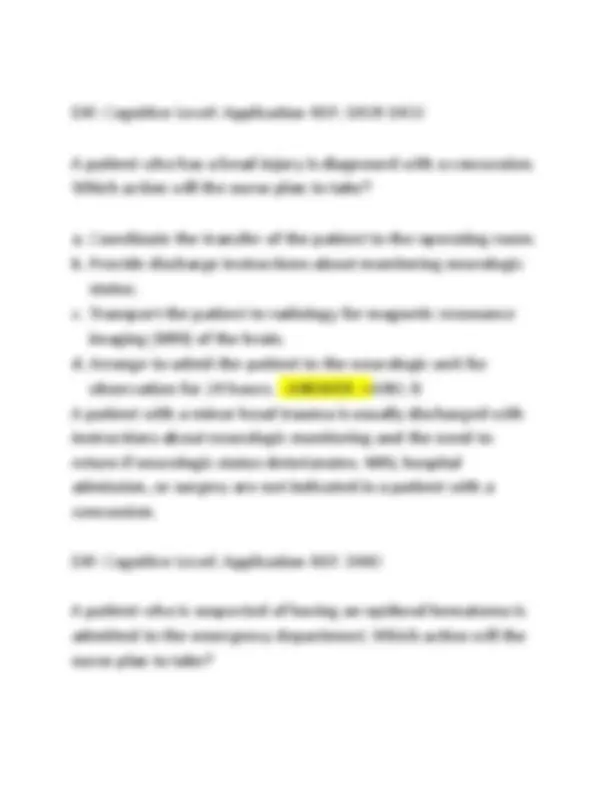
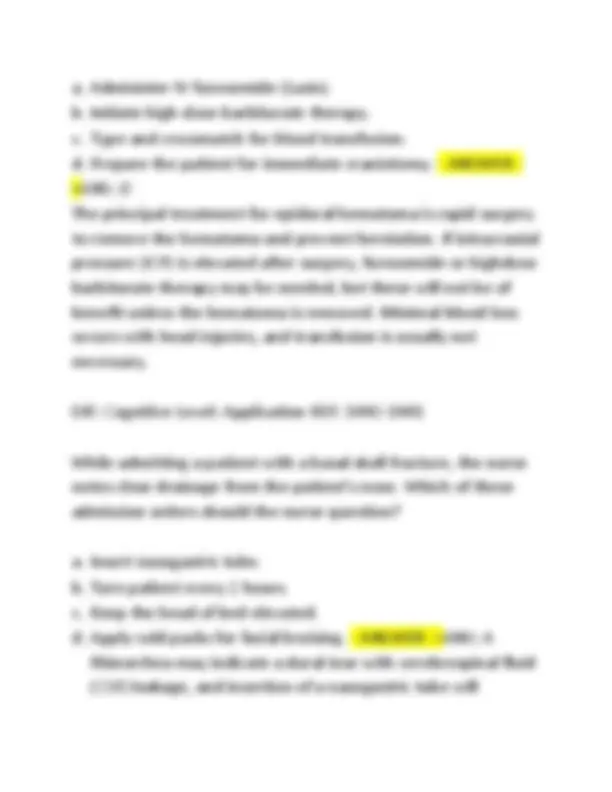
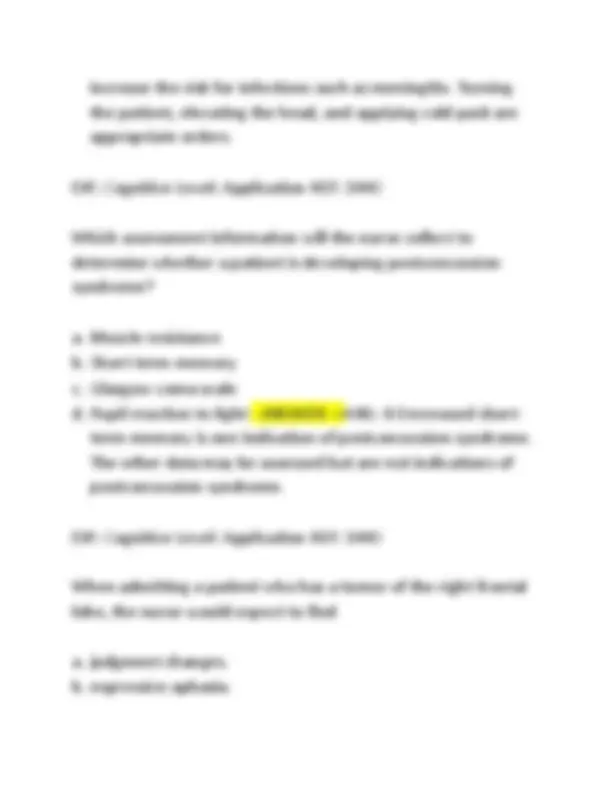
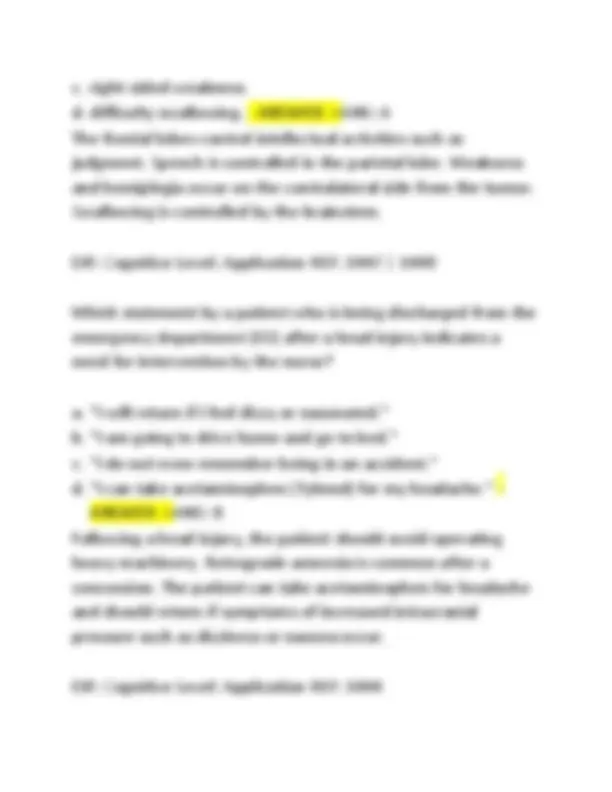
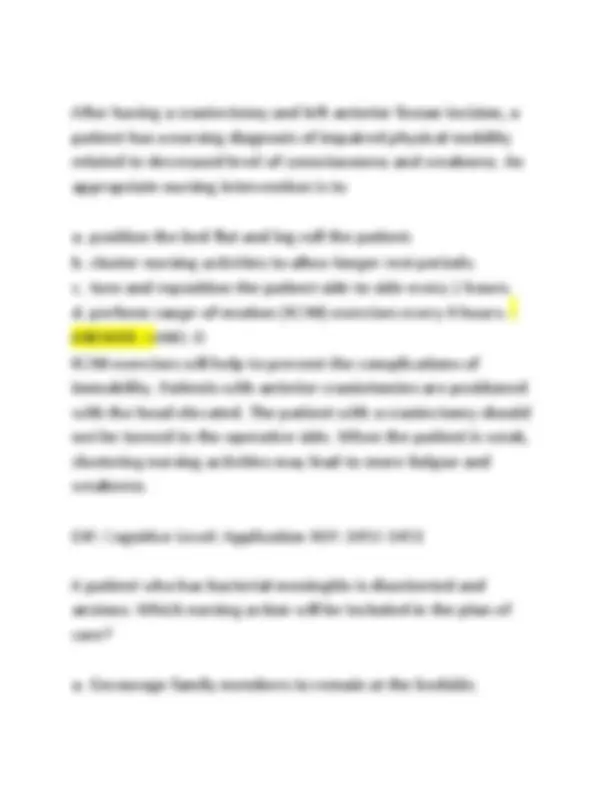
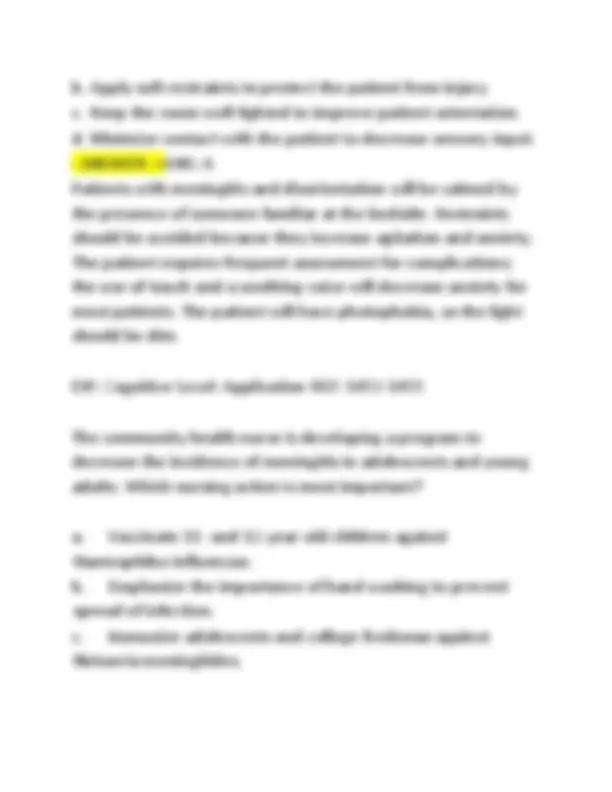
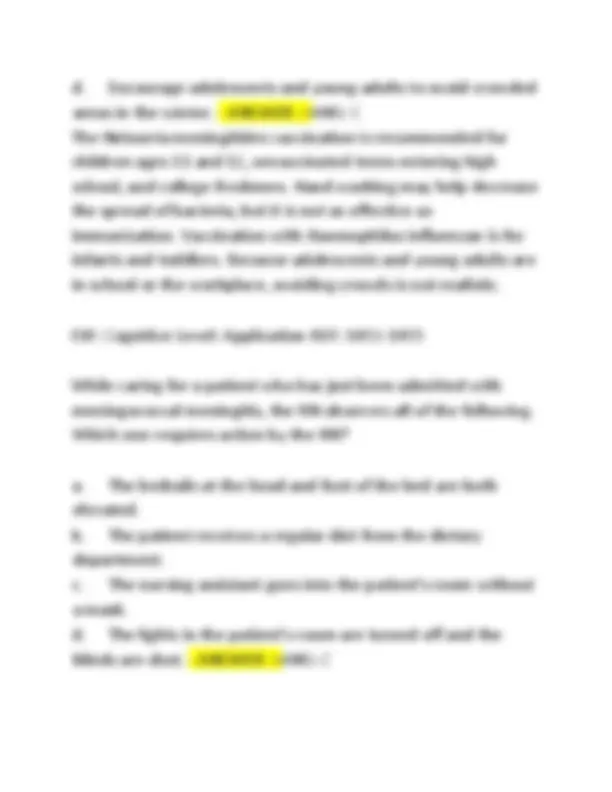
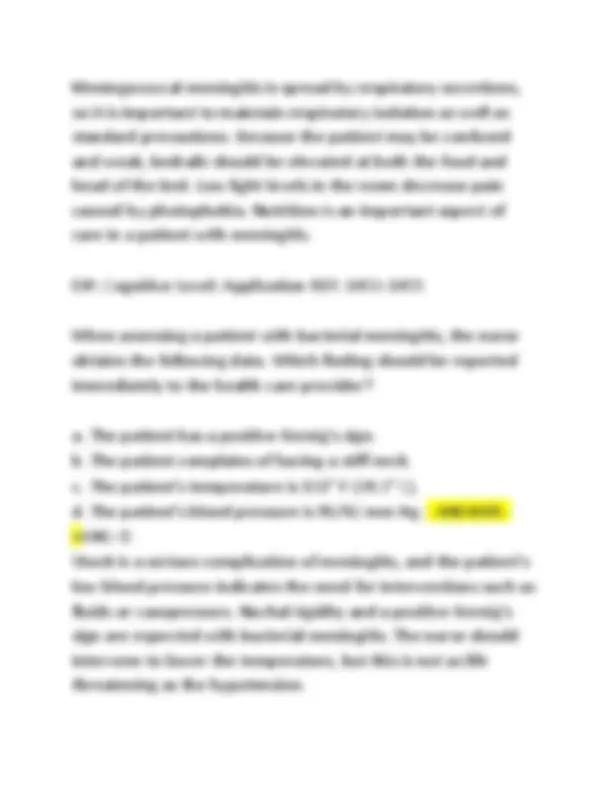
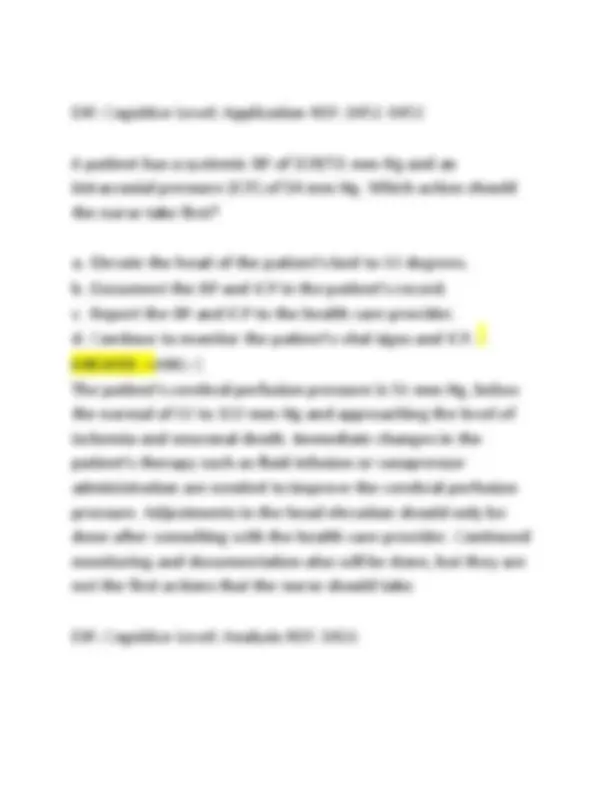
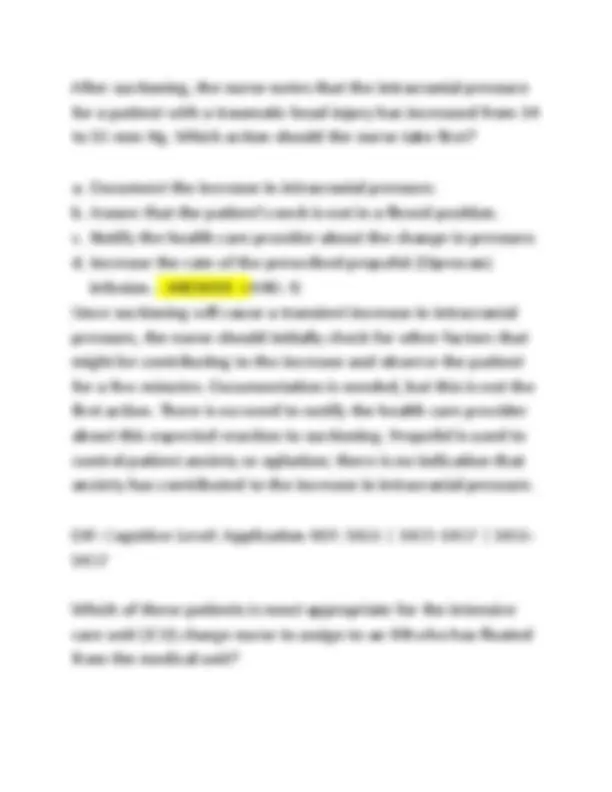
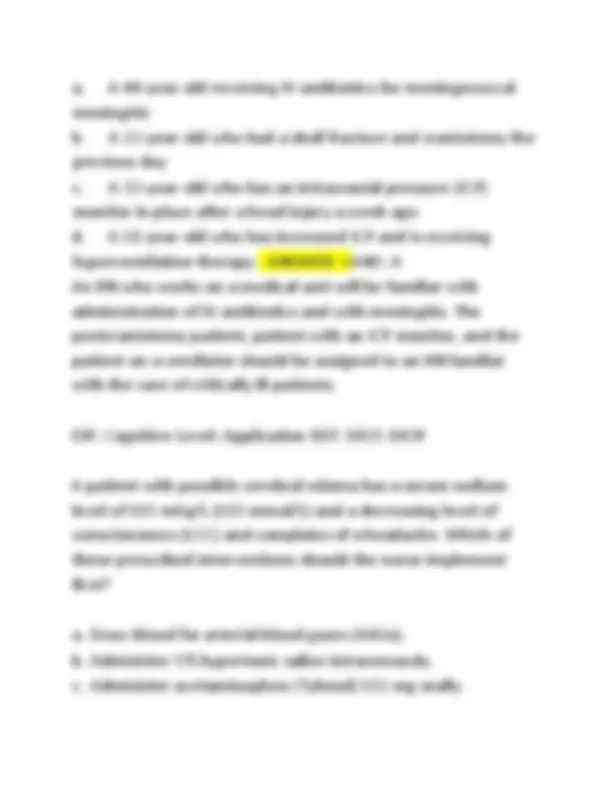
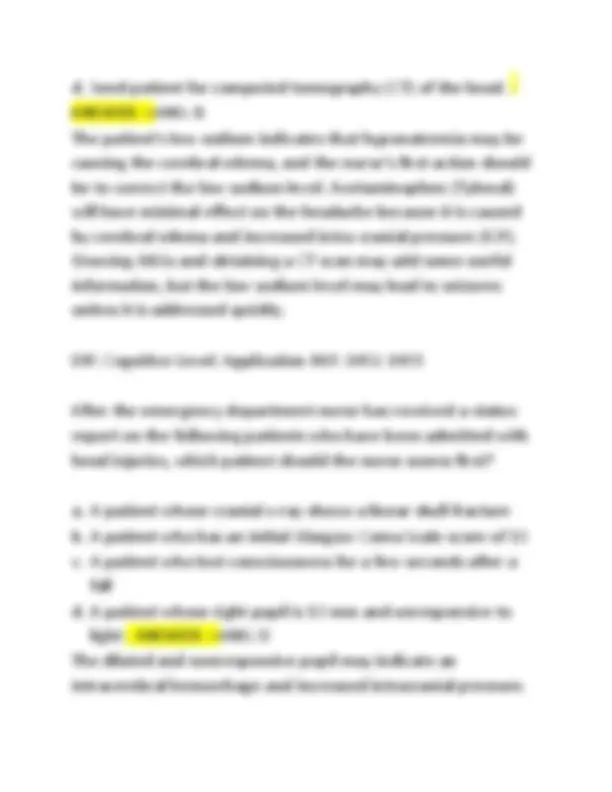
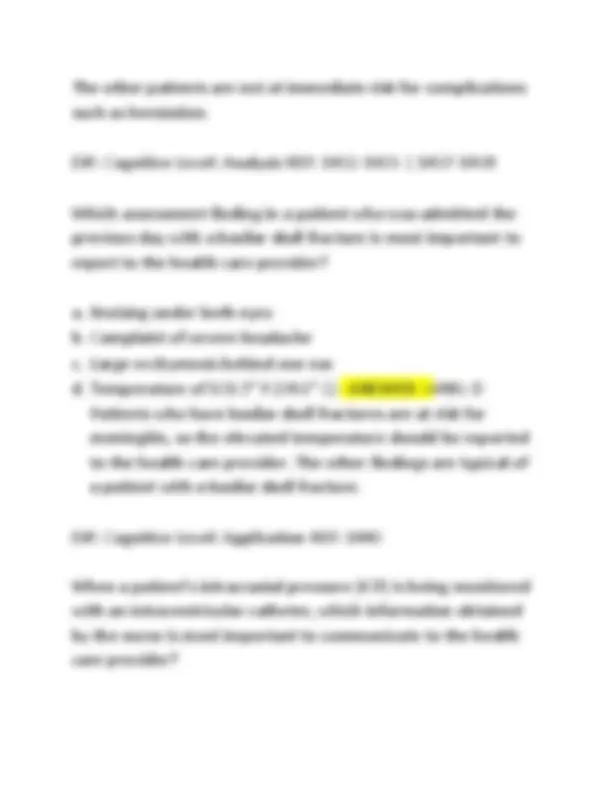
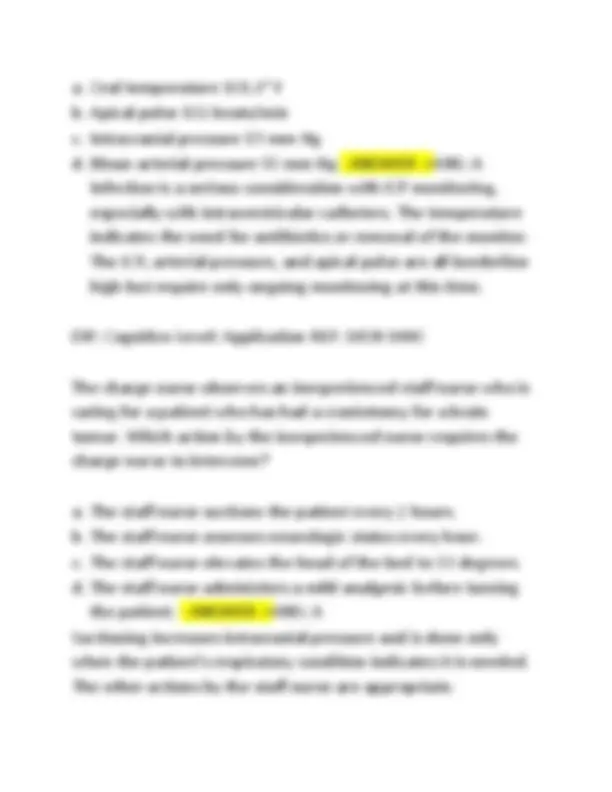
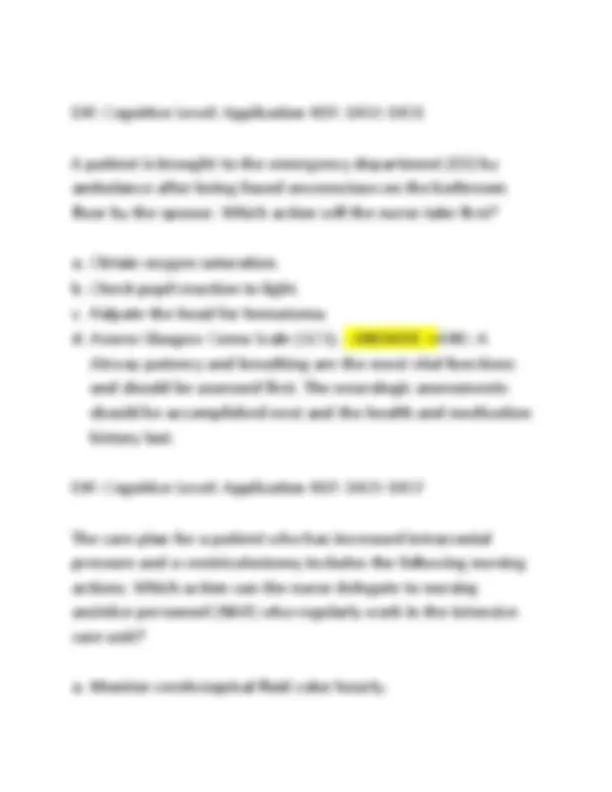
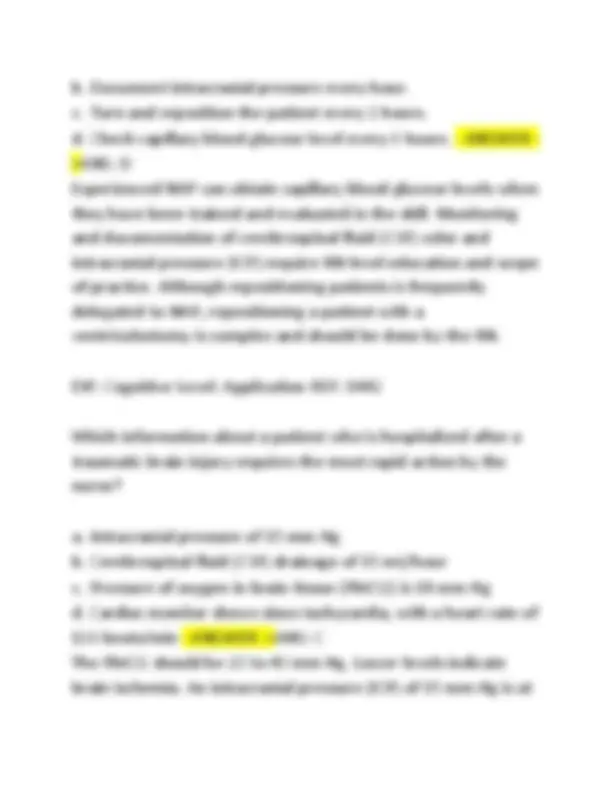
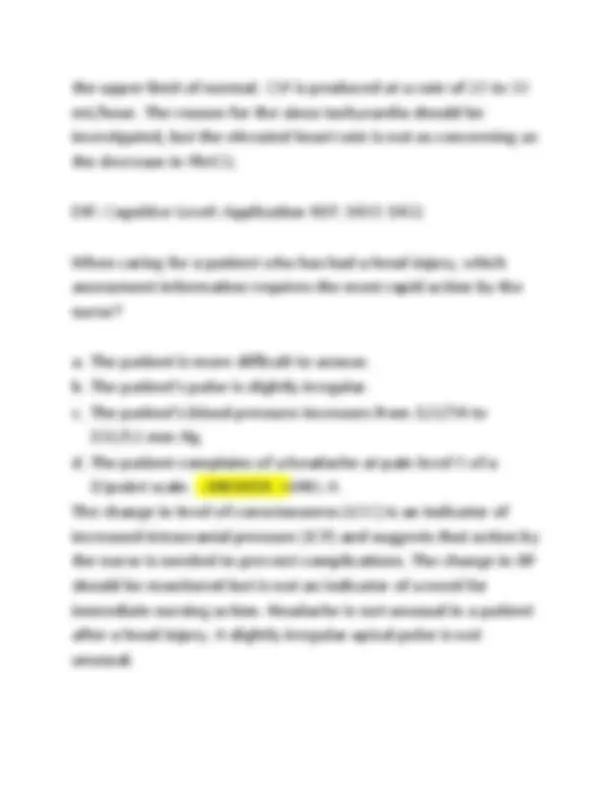
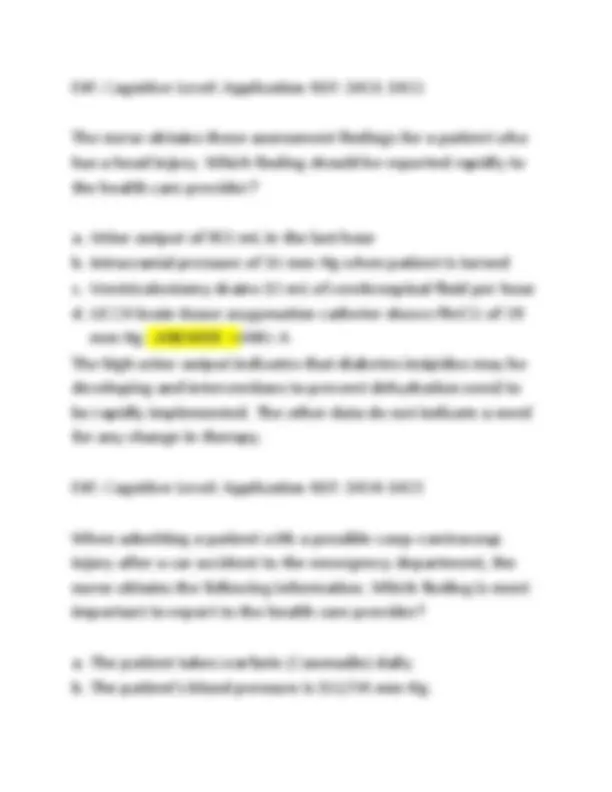
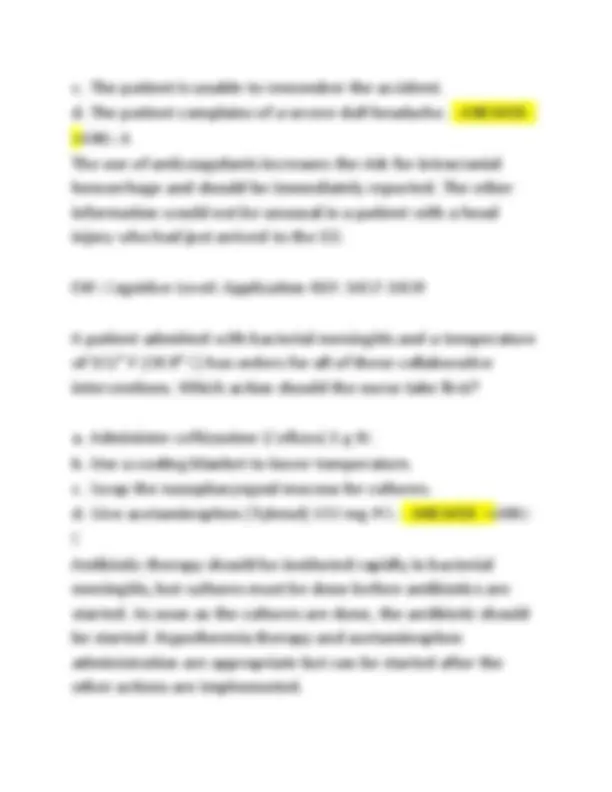
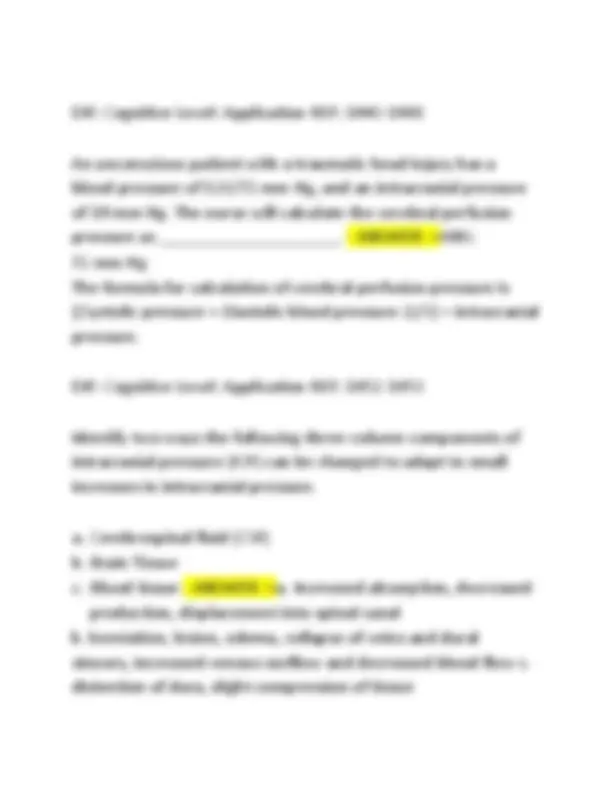
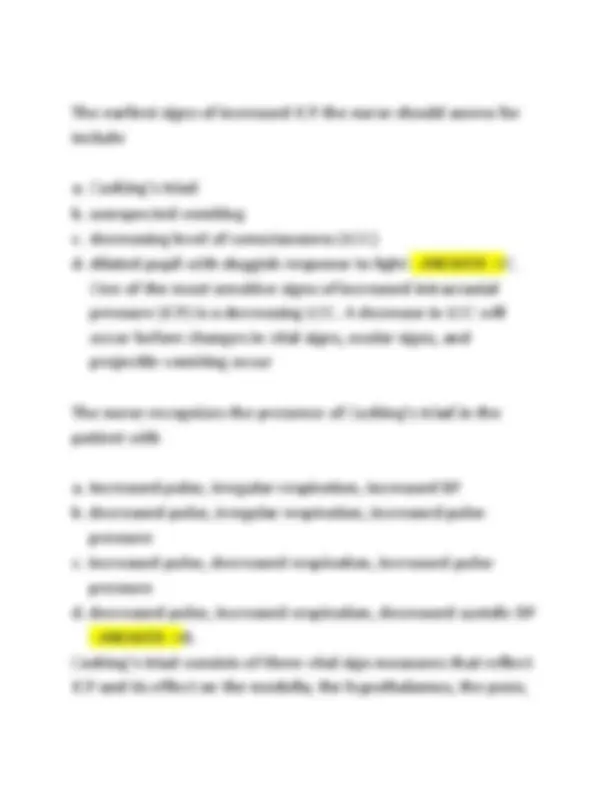
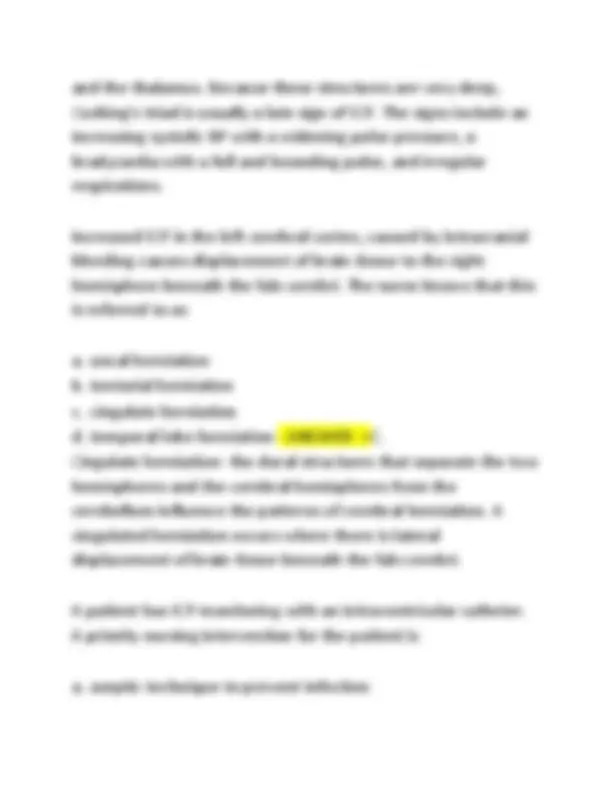
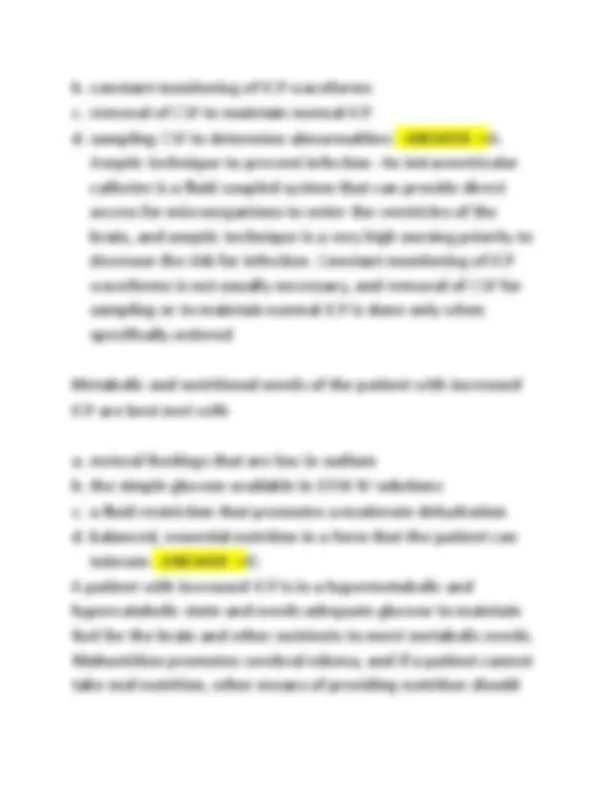
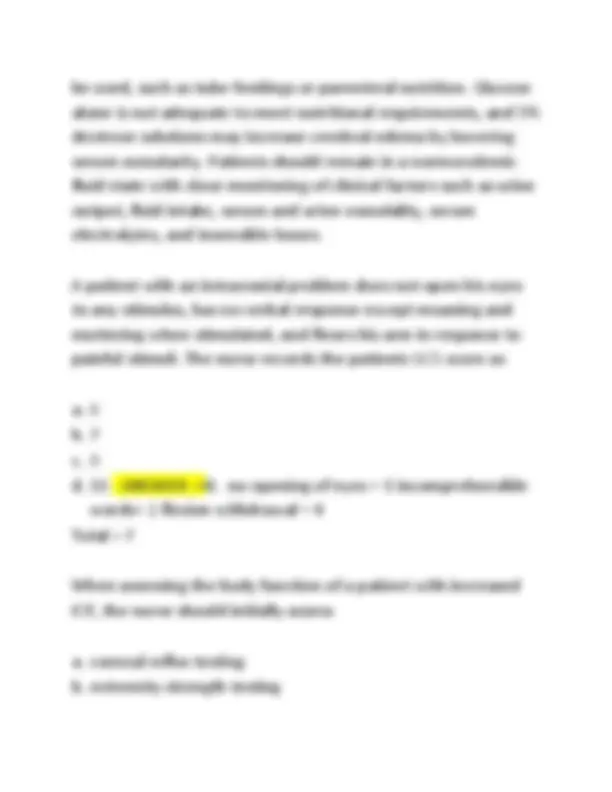
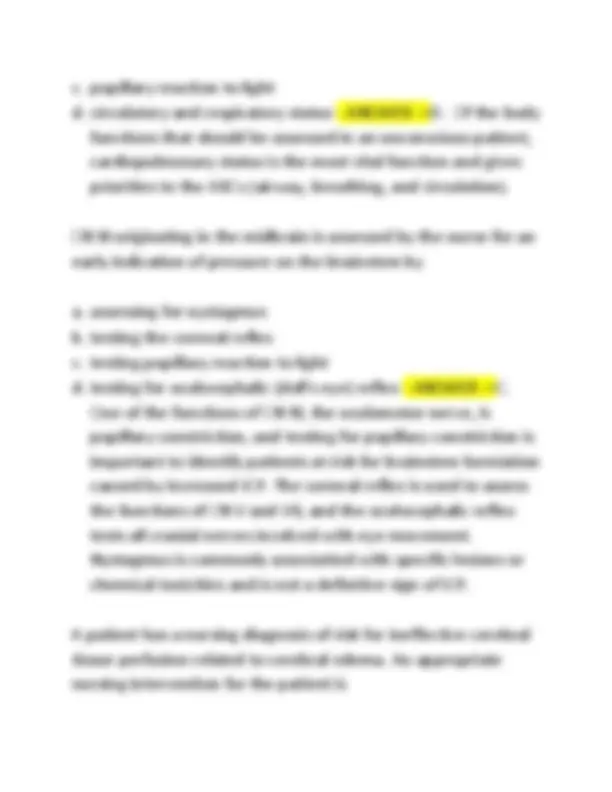
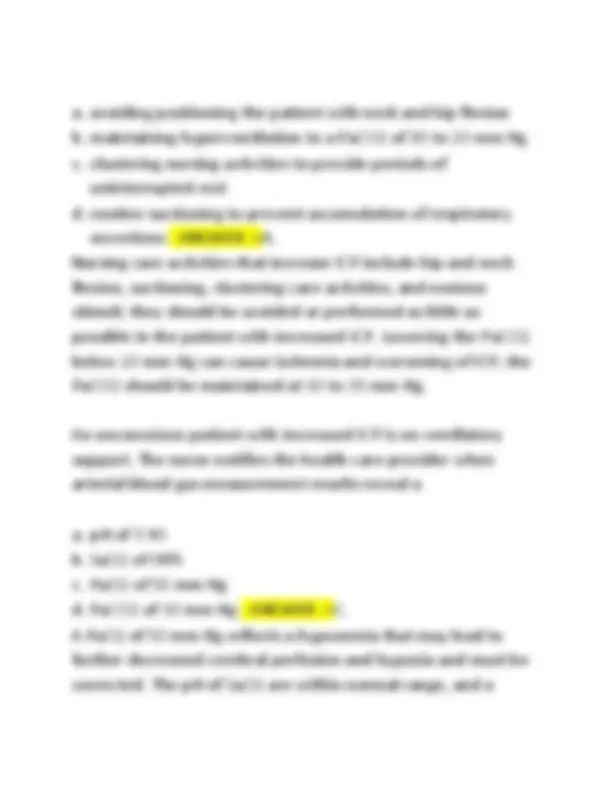
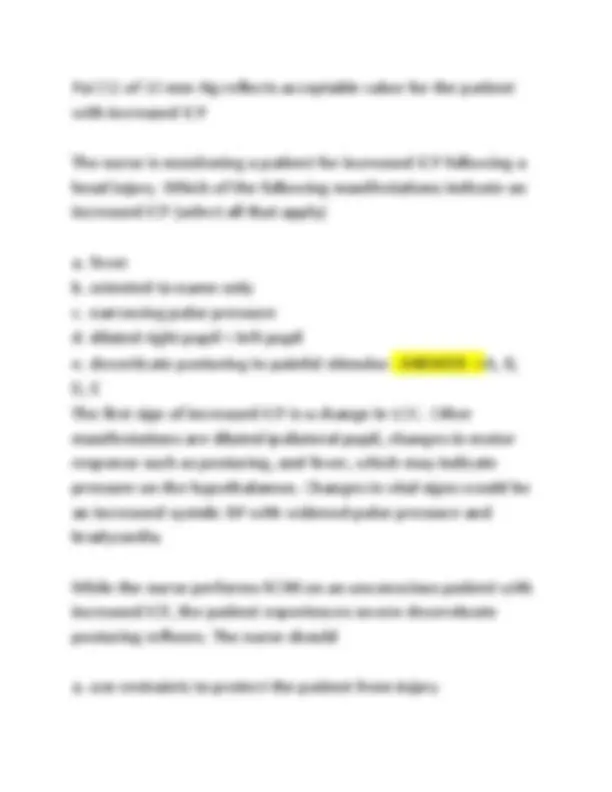
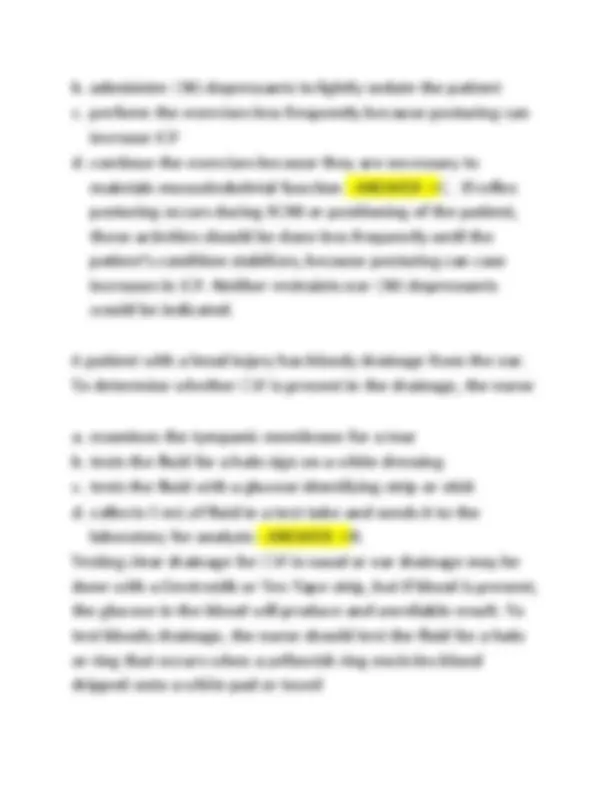
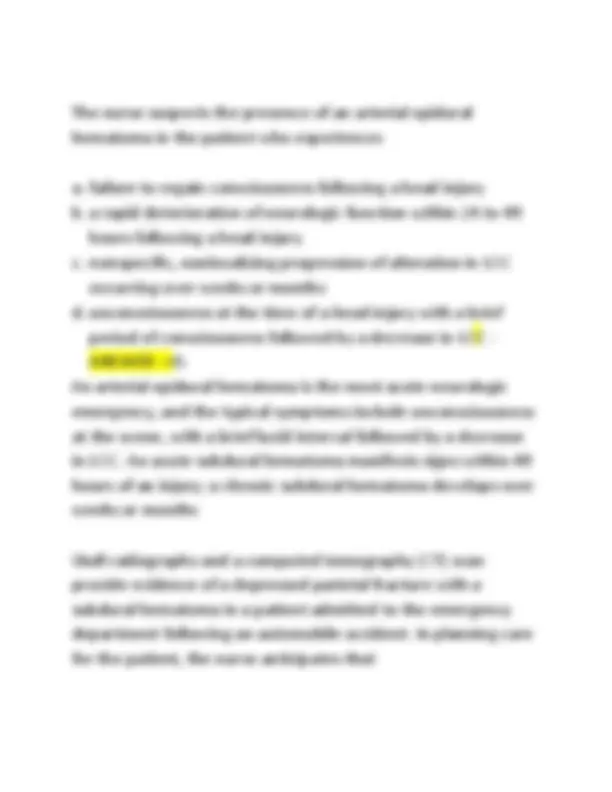
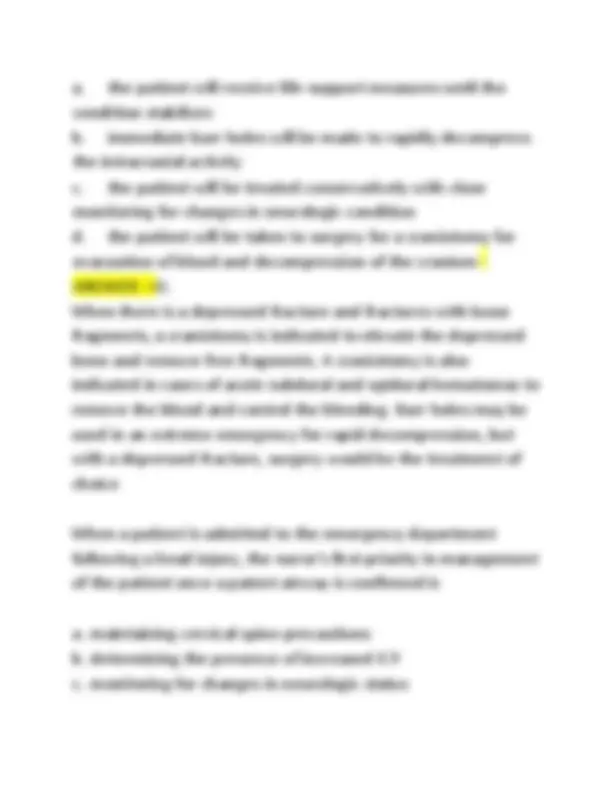
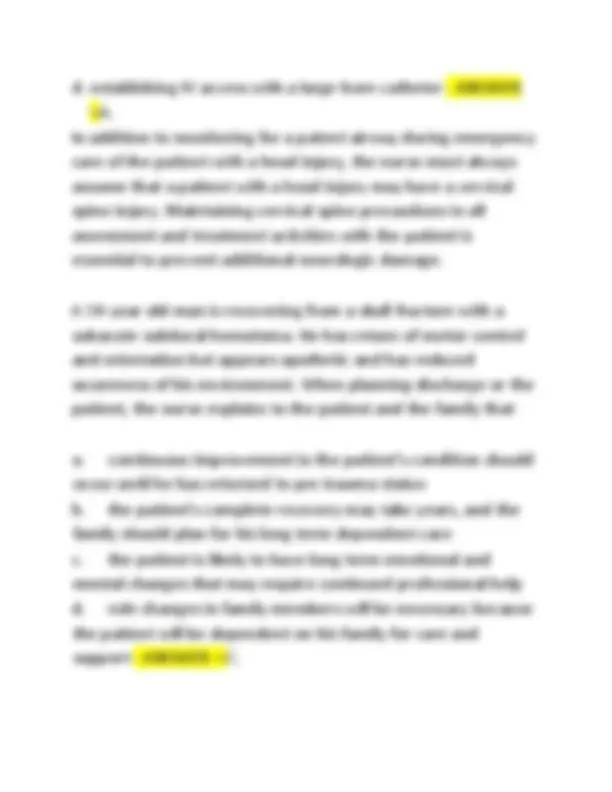
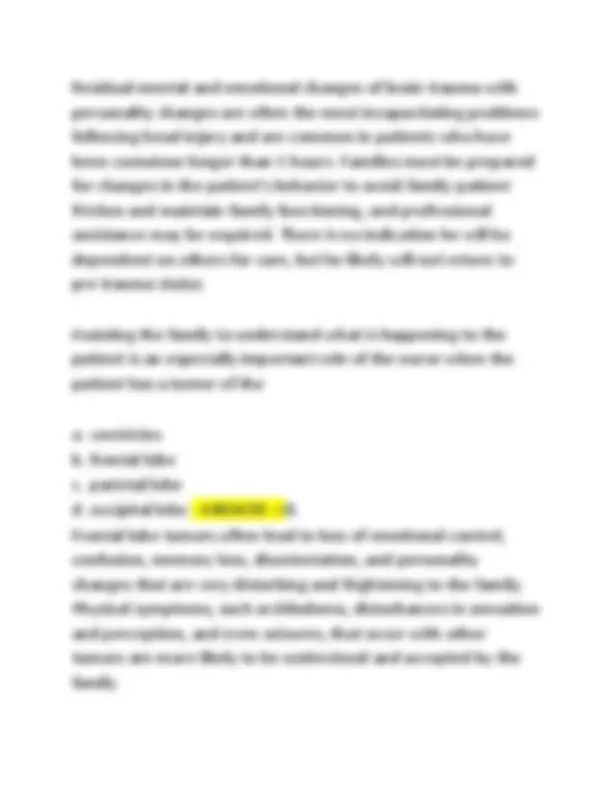


Study with the several resources on Docsity

Earn points by helping other students or get them with a premium plan


Prepare for your exams
Study with the several resources on Docsity

Earn points to download
Earn points by helping other students or get them with a premium plan
Community
Ask the community for help and clear up your study doubts
Discover the best universities in your country according to Docsity users
Free resources
Download our free guides on studying techniques, anxiety management strategies, and thesis advice from Docsity tutors
NSG233 MED SURG 2 EXAM QUESTIONS WITH COMPLETE SOLUTIONS GUARANTEED PASS
Typology: Exams
1 / 124

This page cannot be seen from the preview
Don't miss anything!





























































































When family members ask the nurse about the purpose of the ventriculostomy system being used for intracranial pressure monitoring for a patient, which response by the nurse is best? a. "This type of monitoring system is complex and highly skilled staff are needed." b. "The monitoring system helps show whether blood flow to the brain is adequate." c. "The ventriculostomy monitoring system helps check for alterations in cerebral perfusion pressure." d. "This monitoring system has multiple benefits including facilitation of cerebrospinal fluid drainage." - ANSWER - >ANS: B Short and simple explanations should be given to patients and family members. The other explanations are either too complicated to be easily understood or may increase the family member's anxiety. DIF: Cognitive Level: Application REF: 1438
A patient with a head injury has admission vital signs of blood pressure 128/68, pulse 110, and respirations 26. Which of these vital signs, if taken 1 hour after admission, will be of most concern to the nurse? a. Blood pressure 156/60, pulse 55, respirations 12 b. Blood pressure 130/72, pulse 90, respirations 32 c. Blood pressure 148/78, pulse 112, respirations 28 d. Blood pressure 110/70, pulse 120, respirations 30 - ANSWER
ANS: A Systolic hypertension with widening pulse pressure, bradycardia, and respiratory changes represent Cushing's triad and indicate that the intracranial pressure (ICP) has increased, and brain herniation may be imminent unless immediate action is taken to reduce ICP. The other vital signs may indicate the need for changes in treatment, but they are not indicative of an immediately life-threatening process. DIF: Cognitive Level: Application REF: 1429- 1430 When the nurse applies a painful stimulus to the nail beds of an unconscious patient, the patient responds with internal rotation, adduction, and flexion of the arms. The nurse documents this as
saturation will not directly improve as a result of mannitol administration. DIF: Cognitive Level: Application REF: 1432- 1433 A patient with a head injury opens the eyes to verbal stimulation, curses when stimulated, and does not respond to a verbal command to move but attempts to remove a painful stimulus. The nurse records the patient's Glasgow Coma Scale score as a. 9. b. 11. c. 13. d. 15. - ANSWER - >ANS: B The patient has a score of 3 for eye opening, 3 for best verbal response, and 5 for best motor response. DIF: Cognitive Level: Application REF: 1434 Following a head injury, an unconscious 32-year-old patient is admitted to the emergency department (ED). The patient's spouse and children stay at the patient's side and constantly ask about the treatment being given. What action is best for the nurse to take?
a. Ask the family to stay in the waiting room until the initial assessment is completed. b. Allow the family to stay with the patient and briefly explain all procedures to them. c. Call the family's pastor or spiritual advisor to support them while initial care is given. d. Refer the family members to the hospital counseling service to deal with their anxiety. - ANSWER - >ANS: B The need for information about the diagnosis and care is very high in family members of acutely ill patients, and the nurse should allow the family to observe care and explain the procedures. A pastor or counseling service can offer some support, but research supports information as being more effective. Asking the family to stay in the waiting room will increase their anxiety. DIF: Cognitive Level: Application REF: 1438 An unconscious patient has a nursing diagnosis of ineffective cerebral tissue perfusion related to cerebral tissue swelling. Which nursing intervention will be included in the plan of care? a. Keep the head of the bed elevated to 30 degrees. b. Position the patient with the knees and hips flexed.
is CSF, it will test positive for glucose. Fluid leaking from the nose will have normal nasal flora, so culture and sensitivity will not be useful. Blowing the nose is avoided to prevent CSF leakage. DIF: Cognitive Level: Application REF: 1438- 1439 A patient who has a head injury is diagnosed with a concussion. Which action will the nurse plan to take? a. Coordinate the transfer of the patient to the operating room. b. Provide discharge instructions about monitoring neurologic status. c. Transport the patient to radiology for magnetic resonance imaging (MRI) of the brain. d. Arrange to admit the patient to the neurologic unit for observation for 24 hours. - ANSWER - >ANS: B A patient with a minor head trauma is usually discharged with instructions about neurologic monitoring and the need to return if neurologic status deteriorates. MRI, hospital admission, or surgery are not indicated in a patient with a concussion. DIF: Cognitive Level: Application REF: 1440
A patient who is suspected of having an epidural hematoma is admitted to the emergency department. Which action will the nurse plan to take? a. Administer IV furosemide (Lasix). b. Initiate high-dose barbiturate therapy. c. Type and crossmatch for blood transfusion. d. Prepare the patient for immediate craniotomy. - ANSWER -
ANS: D The principal treatment for epidural hematoma is rapid surgery to remove the hematoma and prevent herniation. If intracranial pressure (ICP) is elevated after surgery, furosemide or highdose barbiturate therapy may be needed, but these will not be of benefit unless the hematoma is removed. Minimal blood loss occurs with head injuries, and transfusion is usually not necessary. DIF: Cognitive Level: Application REF: 1440- 1441 While admitting a patient with a basal skull fracture, the nurse notes clear drainage from the patient's nose. Which of these admission orders should the nurse question? a. Insert nasogastric tube. b. Turn patient every 2 hours.
When admitting a patient who has a tumor of the right frontal lobe, the nurse would expect to find a. judgment changes. b. expressive aphasia. c. right-sided weakness. d. difficulty swallowing. - ANSWER - >ANS: A The frontal lobes control intellectual activities such as judgment. Speech is controlled in the parietal lobe. Weakness and hemiplegia occur on the contralateral side from the tumor. Swallowing is controlled by the brainstem. DIF: Cognitive Level: Application REF: 1447 | 1448 Which statement by a patient who is being discharged from the emergency department (ED) after a head injury indicates a need for intervention by the nurse? a. "I will return if I feel dizzy or nauseated." b. "I am going to drive home and go to bed." c. "I do not even remember being in an accident." d. "I can take acetaminophen (Tylenol) for my headache." - ANSWER - >ANS: B Following a head injury, the patient should avoid operating heavy machinery. Retrograde amnesia is common after a
concussion. The patient can take acetaminophen for headache and should return if symptoms of increased intracranial pressure such as dizziness or nausea occur. DIF: Cognitive Level: Application REF: 1444 After having a craniectomy and left anterior fossae incision, a patient has a nursing diagnosis of impaired physical mobility related to decreased level of consciousness and weakness. An appropriate nursing intervention is to a. position the bed flat and log roll the patient. b. cluster nursing activities to allow longer rest periods. c. turn and reposition the patient side to side every 2 hours. d. perform range-of-motion (ROM) exercises every 4 hours. - ANSWER - >ANS: D ROM exercises will help to prevent the complications of immobility. Patients with anterior craniotomies are positioned with the head elevated. The patient with a craniectomy should not be turned to the operative side. When the patient is weak, clustering nursing activities may lead to more fatigue and weakness. DIF: Cognitive Level: Application REF: 1450- 1451
b. Emphasize the importance of hand washing to prevent spread of infection. c. Immunize adolescents and college freshman against Neisseria meningitides. d. Encourage adolescents and young adults to avoid crowded areas in the winter. - ANSWER - >ANS: C The Neisseria meningitides vaccination is recommended for children ages 11 and 12, unvaccinated teens entering high school, and college freshmen. Hand washing may help decrease the spread of bacteria, but it is not as effective as immunization. Vaccination with Haemophilus influenzae is for infants and toddlers. Because adolescents and young adults are in school or the workplace, avoiding crowds is not realistic. DIF: Cognitive Level: Application REF: 1453- 1455 While caring for a patient who has just been admitted with meningococcal meningitis, the RN observes all of the following. Which one requires action by the RN? a. The bedrails at the head and foot of the bed are both elevated. b. The patient receives a regular diet from the dietary department.
c. The nursing assistant goes into the patient's room without a mask. d. The lights in the patient's room are turned off and the blinds are shut. - ANSWER - >ANS: C Meningococcal meningitis is spread by respiratory secretions, so it is important to maintain respiratory isolation as well as standard precautions. Because the patient may be confused and weak, bedrails should be elevated at both the food and head of the bed. Low light levels in the room decrease pain caused by photophobia. Nutrition is an important aspect of care in a patient with meningitis. DIF: Cognitive Level: Application REF: 1453- 1455 When assessing a patient with bacterial meningitis, the nurse obtains the following data. Which finding should be reported immediately to the health care provider? a. The patient has a positive Kernig's sign. b. The patient complains of having a stiff neck. c. The patient's temperature is 101° F (38.3° C). d. The patient's blood pressure is 86/42 mm Hg. - ANSWER -
ANS: D Shock is a serious complication of meningitis, and the patient's low blood pressure indicates the need for interventions such as
DIF: Cognitive Level: Analysis REF: 1426 After suctioning, the nurse notes that the intracranial pressure for a patient with a traumatic head injury has increased from 14 to 16 mm Hg. Which action should the nurse take first? a. Document the increase in intracranial pressure. b. Assure that the patient's neck is not in a flexed position. c. Notify the health care provider about the change in pressure. d. Increase the rate of the prescribed propofol (Diprovan) infusion. - ANSWER - >ANS: B Since suctioning will cause a transient increase in intracranial pressure, the nurse should initially check for other factors that might be contributing to the increase and observe the patient for a few minutes. Documentation is needed, but this is not the first action. There is no need to notify the health care provider about this expected reaction to suctioning. Propofol is used to control patient anxiety or agitation; there is no indication that anxiety has contributed to the increase in intracranial pressure. DIF: Cognitive Level: Application REF: 1426 | 1435-1437 | 1436- 1437
Which of these patients is most appropriate for the intensive care unit (ICU) charge nurse to assign to an RN who has floated from the medical unit? a. A 44-year-old receiving IV antibiotics for meningococcal meningitis b. A 23-year-old who had a skull fracture and craniotomy the previous day c. A 30-year-old who has an intracranial pressure (ICP) monitor in place after a head injury a week ago d. A 61-year-old who has increased ICP and is receiving hyperventilation therapy - ANSWER - >ANS: A An RN who works on a medical unit will be familiar with administration of IV antibiotics and with meningitis. The postcraniotomy patient, patient with an ICP monitor, and the patient on a ventilator should be assigned to an RN familiar with the care of critically ill patients. DIF: Cognitive Level: Application REF: 1435- 1438 A patient with possible cerebral edema has a serum sodium level of 115 mEq/L (115 mmol/L) and a decreasing level of consciousness (LOC) and complains of a headache. Which of these prescribed interventions should the nurse implement first?
d. A patient whose right pupil is 10 mm and unresponsive to light - ANSWER - >ANS: D The dilated and nonresponsive pupil may indicate an intracerebral hemorrhage and increased intracranial pressure. The other patients are not at immediate risk for complications such as herniation. DIF: Cognitive Level: Analysis REF: 1432-1433 | 1437- 1438 Which assessment finding in a patient who was admitted the previous day with a basilar skull fracture is most important to report to the health care provider? a. Bruising under both eyes b. Complaint of severe headache c. Large ecchymosis behind one ear d. Temperature of 101.5° F (38.6° C) - ANSWER - >ANS: D Patients who have basilar skull fractures are at risk for meningitis, so the elevated temperature should be reported to the health care provider. The other findings are typical of a patient with a basilar skull fracture. DIF: Cognitive Level: Application REF: 1440
When a patient's intracranial pressure (ICP) is being monitored with an intraventricular catheter, which information obtained by the nurse is most important to communicate to the health care provider? a. Oral temperature 101.6° F b. Apical pulse 102 beats/min c. Intracranial pressure 15 mm Hg d. Mean arterial pressure 90 mm Hg - ANSWER - >ANS: A Infection is a serious consideration with ICP monitoring, especially with intraventricular catheters. The temperature indicates the need for antibiotics or removal of the monitor. The ICP, arterial pressure, and apical pulse are all borderline high but require only ongoing monitoring at this time. DIF: Cognitive Level: Application REF: 1438- 1440 The charge nurse observes an inexperienced staff nurse who is caring for a patient who has had a craniotomy for a brain tumor. Which action by the inexperienced nurse requires the charge nurse to intervene? a. The staff nurse suctions the patient every 2 hours. b. The staff nurse assesses neurologic status every hour. c. The staff nurse elevates the head of the bed to 30 degrees.